




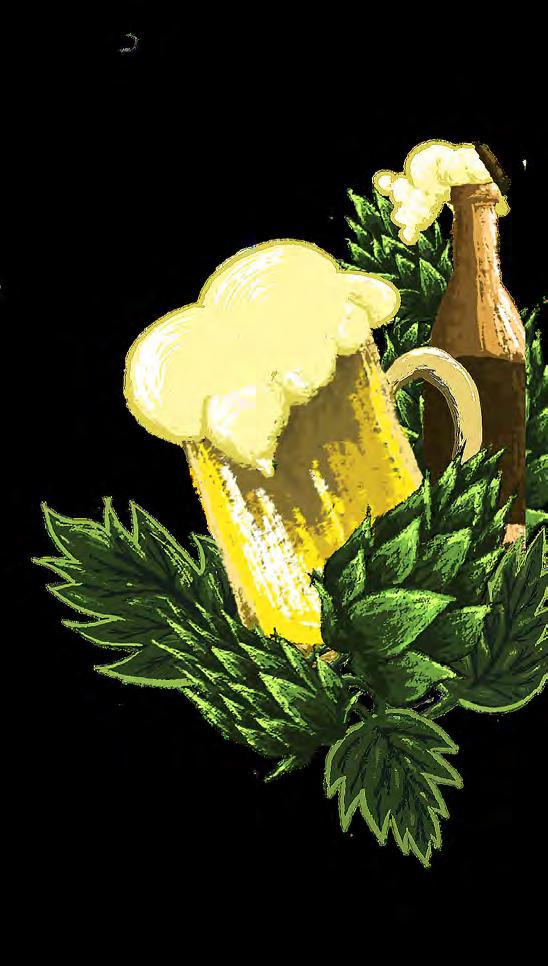

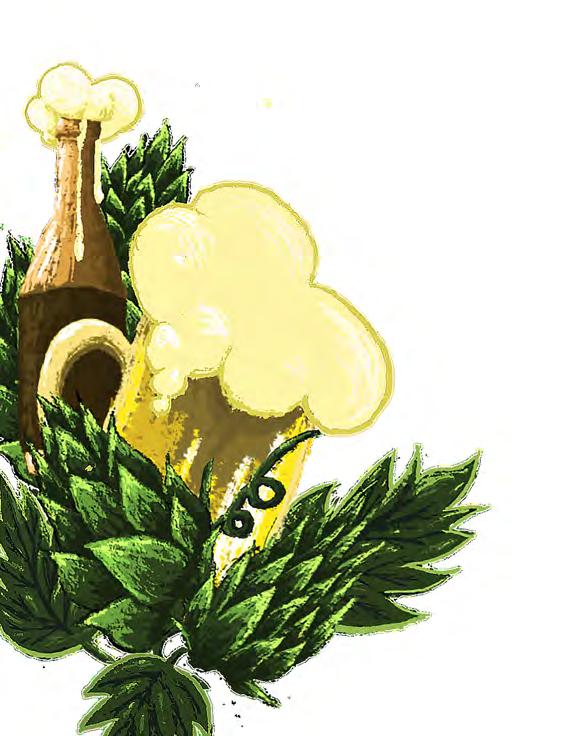




JULY 2023


SPONSORED BY
SPONSORED BY
PUBLISHER & EDITOR-IN-CHIEF: Louis Fortis (ext. 3802)
GENERAL MANAGER: Kevin Gardner (ext. 3825)

MANAGING EDITOR: David Luhrssen (ext. 3804)
BUSINESS MANAGER: Peggy (ext. 3832)


ASSISTANT TO THE BUSINESS MANAGER:
Tanya Bielinski (ext. 3808)
ACCOUNT EXECUTIVES: Bridgette Ard (ext. 3811)
Julee Mitchell (ext. 3831)

Petra Seymore (ext. 3828)
Tyler R. Klein (ext. 3815)
SALES MANAGER: Jackie Butzler (ext. 3814)

BUSINESS DEVELOPMENT MANAGER: Chuck Hill (ext. 3822)
IN MEMORY OF DUSTI FERGUSON (OCTOBER 18, 1971 – NOVEMBER 20, 2007)
WEBMASTER: Barry Houlehen (ext. 3807)


DIGTAL STRATEGIST: Allen Halas (ext. 3803)
STAFF WRITER & CIRCULATION COORDINATOR: Blaine Schultz (ext. 3813)
INTERN: Sabrina Rosler

Layout and design by WaterStreet Creative.
SPONSORED BY
FOR MORE UNIQUE CONTENT, VISIT SHEPHERDEXPRESS.COM.
Distribution: New issues of the Shepherd Express magazine are on the street, on the first Wednesday of each month, free of charge. The Shepherd Express may be distributed only by authorized distributors. No person may, without prior written permission of the Shepherd Express, take more than one copy of each monthly issue. Mail subscriptions are available. No refunds for early cancellations. One year (12 issues) via First Class mail: $100.00.
207 E. Buffalo St., Suite 410, Milwaukee, WI 53202

Phone: 414/276-2222 Fax: 414/276-3312
Advertising Inquiries: jackie@shepex.com
e-mail: info@shepex.com
URL: shepherdexpress.com
SHEPHERD EXPRESS MAKES NO REPRESENTATIONS OR WARRANTIES OF ANY KIND, WHETHER EXPRESSED OR IMPLIED, REGARDING ANY ADVERTISING. DUE DILIGENCE IS RECOMMENDED BEFORE ENTERING INTO ANY AGREEMENT WITH AN ADVERTISER.SHEPHERD EXPRESS WILL NOT BE HELD LIABLE FOR ANY DAMAGES OF ANY KIND RELATING TO ANY AD. PLEASE CHECK YOUR AD THE FIRST DAY OF PUBLICATION AND NOTIFY US OF ANY CHANGES. WE ARE NOT RESPONSIBLE FOR ERRORS IN ADVERTISING AFTER THE FIRST DAY. WE RESERVE THE RIGHT TO EDIT, REJECT OR RECLASSIFY ADVERTISEMENTS AT OUR SOLE DISCRETION, WITHOUT NOTICE. WE DO NOT KNOWINGLY ACCEPT ADVERTISEMENTS THAT DISCRIMINATE OR INTEND TO DISCRIMINATE ON ANY ILLEGAL BASIS, OR ARE OTHERWISE ILLEGAL. NO REFUNDS FOR CANCELLATION AFTER DEADLINE, NO COPY CHANGES EXCEPT TO PRICE OR TELEPHONE NUMBER.

NEWS 05 Did the Municipal Court Strike a Blow Against Poor People? 07 Asphalt Addiction: Wisconsin's Highway Funding Dilemma 12 This Modern World 14 The Secret GOP Code for Abolishing Equal Access to Higher Education — Taking Liberties 16 The Essential Worker Paradox — Issue of the Month 18 Lauryn Cross Supports Advocates for Racial Justice — Hero of the Month 20 Wisconsin Bike Fed Executive Director Kirsten Finn — MKE SPEAKS: Conversations with Milwaukeeans FOOD & DRINK 22 Comet Cafe Still Worth the Wait 24 Savage Pesto — Flash in the Pan SPECIAL SECTION 26 The Brewers at Midseason — Sports Spotlight 28 Protect Your Pets from Summer Pests — Pets 30 Health & Wellness 30 What's Your Poison? — True Health 32 The Mind of a Misogynist — Out of My Mind 34 When a Partner Doesn't Take Your Boundaries Seriously — SexPress 38 Kelly's Greens Elevates the Cannabis Edibles Market — Cannabis 41 Learn to Manage Personal Debt — Personal Finance 44 Summer Drink 44 Three Summer Loves — Beverages 48 History is Brewing at Old World Wisconsin 52 O utdoor Dining & Drink CULTURE 58 Robin Pluer Back for Bastille Days 60 This Month in Milwaukee HEAR ME OUT 66 Summer Craziness — Dear Ruthie 68 The End of an Era: After Three Decades, Milwaukee's LGBTQ Literary Oasis, Outwords Books, Closes — My LGBTQ POV ART FOR ART'S SAKE 70 From the City that Always Sweeps SPONSORED BY
SCAN ME 24 48 38
COVER: Rob Novak pictured, Historic Brewing Experience Coordinator at Old World Wisconsin. Photo coutesy of Wisconsin Historical Society. Illustrations by Tim Czerniakowski.
18 4 | SHEPHERD EXPRESS
Did the Municipal Court Strike a Blow Against Poor People?
BY GRETCHEN SCHULDT
Milwaukee Municipal Court’s decision to terminate its contract with a key agency angered key constituencies and put the court itself in a time bind when it comes to finding an alternative.
Ald. Jonathan Bostroff expressed skepticism that services could continue without a gap. “Even if that was less than a year there is still a significant amount of harm,” he said during a meeting last week of the Common Council’s Judiciary and Legislation Committee.

A month after providing the final notice of termination and just three weeks until the contract actually ends on July 11, the court hasn’t begun to work with JusticePoint to smoothly transition to whatever comes next.
The court is working on a transition plan, Chief Court Administrator Sheldyn Himle said. With Municipal Judge Phil Chavez returning from vacation this week “we will be able to solidify JusticePoint’s piece of the transition,” she said Sunday.
JusticePoint, which administers the Court Alternatives Program, does a lot. It evaluates defendants’ financial situations and any substance-abuse treatment, mental health, housing or job needs. It makes recommendations to Municipal Court for sentencing alternatives, such as community service or money forfeitures. It ensures that Municipal Court judges are aware if a jailed defendant may qualify for a “time served” sentence. It identifies potential community service sites and matches defendants with appropriate community resources and treatment providers. It follows up with clients and the court.
The court notified JusticePoint on May 15 that its contract would terminate July 11, less than six months before its scheduled Dec. 31 expiration date. Judges Chavez and Valarie Hill, working through Himle, approved the ouster of JusticePoint without telling newly elected Judge Molly Gena, who took office May 1, anything about it.
JusticePoint’s major sin apparently was providing copies of citations to Legal Action of Wisconsin lawyers representing
NEWS
JULY 2023 | 5
Photo by jferrer/Getty Images.
the indigent clients who got the tickets. JusticePoint CEO Nick Sayner said the arrangement was agreed upon at least five years ago in a series of meetings with city officials, including representatives from the city attorney’s office.
Himle said in an email to a JusticePoint staff member that JusticePoint should not have provided the citations to Legal Action.
HUSH HUSH
The court has been publicly pretty hush-hush about the reasons for the termination and city officials talk vaguely about serious issues or allegations but refuse to say what they are. Sayner said the citation issue is the only one he knows about.
There also was disagreement about whether, during a May 4 or 5 meeting, Himle set a May 11 deadline for JusticePoint to submit recommendations for possible solutions. Himle said she did; Sayner said Himle expressed a preference but did not set a hard deadline. JusticePoint submitted its proposal on May 15, Sayner said. The city’s termination notice was received later that day.
Himle told the committee last week that the three Municipal Court judges could make referrals to service agencies after JusticePoint’s termination takes effect, then could issue a sole-source contract, followed by a full request for proposals.
Neither Chavez, who was out of the country, nor Hill showed up to the committee hearing, but Gena did, and she was clearly not happy with the termination decision.
While Hill and Chavez may have a post-7-11 plan, “I don’t,” Gena said. “I don’t know what is going to happen after July 11.”
“While I can order fines and ask them (defendants) to pay those fines, what’s really going to get at that root behavior and what’s really going to stop them from coming back in front of my court is that treatment, and it’s incredibly important,” she said.
DIMINISHED SERVICES

The court is canceling the contract for “convenience,” meaning it just needs to give 10 days’ notice of the action.
Whatever the city comes up with, it is likely to be a diminished program. Take Himle’s contention that judges could make referrals. Sure, but will they, as JusticePoint does, also take referrals from the Milwaukee Police Department, the Milwaukee County Sheriff’s Department, the defendants themselves, community-based programs and treatment providers, the state Department of Corrections, private attorneys, family members, and the City Attorney’s office?
Sometimes, Sayner said, Municipal Court security staff will ask JusticePoint to take a look if a defendant appears to need help.
Sayner said he does not think the two judges know how the program works on a day-to-day basis. Neither Hill nor Chavez has met with the JusticePoint management team for years.
JusticePoint, which also coordinates pretrial services in criminal cases for Milwaukee County, leverages its dual roles to get access to information another vendor may not be able to obtain easily or at all, Sayner said.
In its county role, agency employees are available 24 hours a day and interview 16,000 to 20,000 arrestees annually. That allows the agency to identify arrestees with Municipal Court cases who might be eligible for the alternatives program.
JusticePoint also operates and pays for a Municipal Court data system for which the costs are split between five court systems, including the Municipal Court. When the JusticePoint contract ends, the city needs another system.
The agency has access to the county’s pretrial system, where the agency keeps case notes and risk assessment information. JusticePoint staff members also are trained in a variety of assessment tools, some of which take considerable training or certification to administer, Sayner said. The agency uses at least some of the assessments with every defendant it interviews, he said.
Will the next vendor have access to those things? Or will the city ultimately make less effort to offer alternatives and instead seek forfeitures from people who have no money?
As the U.S. Justice Department said in an April “Dear Colleague” letter, imposing fines and fees while failing to “take account of other public policy concerns, may erode trust between local governments and their constituents, increase recidivism, undermine rehabilitation and successful reentry, and generate little or no net revenue.”
Let’s hope Municipal Court officials are paying attention.
6 | SHEPHERD EXPRESS NEWS
Gretchen Schuldt is a writer and researcher for the Wisconsin Justice Initiative.
ASPHALT ADDICTION: WISCONSIN'S HIGHWAY
FUNDING DILEMMA
CAN WISCONSIN HIGHWAYS HANDLE YOUR PLANNED SUMMER ROAD TRIPS?
BY LEN NELSON
Almost everyone who has traveled Wisconsin highways, whether for commuting or for pleasure, has likely encountered an occasional bone jarring, vehicle rattling and tire challenging ride over rough and pothole covered pavement. But tackling the problem requires lots of money and finding such funding has vexed many a government administration. Highways are expensive to build and maintain, after all, and the pressing issue facing the state is how to remedy an antiquated funding mechanism.
There is growing pressure to change the way the state funds construction and repairs to deal with what will be an ever more problematic budgeting issue as traditional methods of paying for highways have become inadequate and unsustainable. Here, we’ll look at how we got to where we are and whether we should wean ourselves from the idea that we even need more major highway construction projects. We’ll also look at some proposed longterm solutions.
While the state has targeted most of its transportation dollars to infrastructure designed for personal vehicles, mass transit has been largely ignored by leadership. Proposals to build rail corridors which would connect major population hubs like Milwaukee, Madison and the Fox Valley have languished. Most notably, after Republican Governor Tommy Thompson and then Democratic Governor Jim Doyle began investing in a project to build a high-speed passenger rail line between Milwaukee and Madison, the project was killed by GOP Gov. Scott Walker in 2010. The state was slated to receive $810 million in federal funds for the project, but Walker insisted that the money be spent instead on highway construction. It was a colossal miscalculation, however, because the federal government retracted the money from Wisconsin and awarded it to other states. The Feds told Walker that, by law, those funds had to be used for passenger rail systems, not highways.
The project included development of a passenger rail car manufacturing plant in a distressed area near Capitol Drive and North 27th Street in Milwaukee in cooperation with the Spanish manufacturer Talgo. While Talgo still operates the plant, the rail cars intended for use in Wisconsin sat idle for years.
Republicans who controlled the state legislature could not agree on a plan to use the rail cars for Amtrak’s Hiawatha train service which connects Milwaukee and Chicago. Finally, only last year, some cars were purchased by Nigeria. But Wisconsin lost millions of dollars in canceled contracts. The Talgo plant employs about 120 people, and its owner says he is optimistic that Wisconsin will again look at high speed rail given a renewed priority on mass transit and federal funding under the Biden administration. However, that will require the state to get on board with such plans and that prospect does not appear likely with Republicans still in control of the legislature.
JULY 2023 | 7
Illustrations by Tim Czerniakowski.
TAKE THE TRAIN
By contrast, Wisconsin Senate Minority Leader Chris Larson (D-Milwaukee) said he supports development of more passenger rail between population hubs and also an expanded streetcar system within the City of Milwaukee. “I think it would be smart and I’ve been advocating for that for the last 15 years,” Larson said. “The way we fund transportation currently shows where the real priority is, and I would hope that would change in Wisconsin. But we’ve unfortunately had a few Neanderthals in charge who are scared of rail and refuse to look toward the future of transportation. It’s absolutely ludicrous. We could have been way ahead of other states in that respect, but Walker threw it away.”
The attitude among Republicans about mass transit doesn’t appear to have changed. The GOP-sponsored shared revenue bill, which passed on a partisan vote in the Assembly on May 17, includes a provision barring the City of Milwaukee from using sales tax revenue to extend its streetcar line. “They have not learned their lesson. They are still very much against the idea of using mass transit,” Larson said. “It falls along party lines for whatever reason.”
There is real world evidence that urban light rail mass transit can work to alleviate pressure on highway systems. When Minneapolis invested in a light rail system which connects its suburbs to the downtown and neighboring St. Paul, critics called it a boondoggle which would negatively impact impoverished neighborhoods much as major freeway construction has in cities like Milwaukee. Freeways have created physical barriers which divide communities and cause further transportation difficulties for residents of limited means. But ridership on the light rail system has steadily increased each year in Minneapolis and businesses near the rail lines say they have seen increased commercial activity because people have better and easier access to them. The city is in the process of expanding its rail lines.
Larson said state and local governments need to be proactive in the way they fund transportation infrastructure and must include mass transit in future planning, especially in the Milwaukee area. “Milwaukee County doesn’t have dedicated funding for its transit system and we’re one of the only transit systems in the country to be that way,” he said. “We’re one of the last 5% not to have dedicated funding for transit so it’s always on the chopping block when it comes to the things the county needs to fund. It’s just not a smart way to go about it. Instead, we just keep adding more lanes to highways which studies show doesn’t ease traffic congestion. We spend hundreds of millions of dollars where we would get more bang for our buck by investing in mass transit at the local level.”
Studies have also shown that mass transit is mostly used by people of limited means who have no other options. But attitudes are changing in that regard, especially among people who now realize that their gas-powered vehicles contribute mightily to carbon emissions and climate change. To ensure that such systems are successful, Larson said it will require an extensive marketing effort to encourage people to consider mass transit instead.
NEW OPTIONS?
So, because the state will not be able to afford to maintain its existing highways and roads under a funding system which cannot provide the revenue it will require in the near and long-term future, are there any other options? The answer is an emphatic maybe. There are experiments underway in several states which would shift highway funding away from gas taxes and toward a mileage-based system in which drivers would pay according to actual road use. But Larson said such an approach belies the actual contributor to most road damage, heavy trucks. He said a universal per-miles traveled method of
highway funding puts an unfair burden on regular motorists. He said he prefers a higher usage fee on operators of heavy trucks. “If we’re going to talk about a mileage-based fee, it could make sense. But it has to be structured around vehicle weight, around the ones which are causing the most road damage,” he said. “But every time we talk to the DOT about it, they aren’t even looking at that even though it would make the most practical sense.”
If Wisconsin and other states don’t address the funding dilemma and allow highway maintenance budgets to fall behind what is required to keep highways in good condition, the economic cost could be catastrophic. The worse a road becomes, the more it costs to repair in the long run. To that we'll have to add in increased costs to residents and businesses from vehicle damage caused by poor highways. Quality transportation infrastructure which allows workers to get to their places of employment are factors considered by businesses when seeking locations to establish or expand offices or manufacturing plants. If those needs aren’t addressed, the eventual result could devastate the Wisconsin economy. The data shows that the current structure simply will not suffice.
In Wisconsin, highway construction and maintenance are funded by a combination of gasoline taxes and vehicle registration fees. However, rev-
Czerniakowski. 8 | SHEPHERD EXPRESS NEWS
Illustrations by Tim

enue from those sources is not keeping up with expenditures and the gap is widening. Most transportation experts and many lawmakers believe state and federal governments must create alternative revenue streams to replace declining dollars from per gallon gasoline taxes.
There are several factors behind a decline in gas tax revenues. Among them is the increased popularity of hybrid and fully electric vehicles. They don’t use nearly as much gasoline, if any at all. Electric car drivers won’t gas and won’t pay gas taxes. Growth in the market share for EVs is increasing quickly and dramatically. According to a Bloomberg report, global EV sales climbed from 450,000 in 2015 to 1.7 million in 2020 and are expected to reach 54 million by 2040. At least 10 automakers are promising to make only electric options in the coming years, one of them slated to cease offering gasoline engine options as soon as 2025. Even using a relatively conservative market penetration estimate, it’s expected that EV sales and use will reduce fuel tax revenue by as much as 43% by 2050.
The state legislature has attempted to create a revenue stream to replace that which will increasingly be lost because of hybrid and electric vehicles through a surcharge on registration fees for them. But the surcharge currently generates only about $8.5 million each year, just a tiny fraction of the revenue which comes from gas taxes.
HIGH MILEAGE
Of course, most of us still drive cars or trucks with internal combustion engines and they will still be with us for decades. But modern gas-powered vehicles get far better mileage than they did in the past as fuel efficiency standards have forced manufacturers to build cars and trucks designed to go further on less fossil fuel. When vehicles don’t need as much gas, operators won’t be paying as much in fuel taxes.
Annual revenue from Wisconsin’s gas tax brings in a little over a billion dollars each year but the state’s existing road construction and repair schedule will require far more funding than it provides. Some lawmakers tout a simplistic solution to just raise the taxes on gas which have remained at the same level for decades. The federal tax on gasoline is 18.4 cents per gallon and 24.4 cents per gallon for diesel. There has been no increase since 1993 when Congress ended yearly indexing which accounted for inflation. Likewise, the state gas tax in Wisconsin of 30.9 cents per gallon hasn’t seen an increase since 2006. Before 1983, any hike in the state gas tax required specific action by the legislature. From 1983 to 2006, annual increases in the tax were auto -
matically indexed to inflation. Indexing was ended by the legislature in 2006, though, and the tax has remained unchanged since despite numerous proposals to increase it.
In 2016, Assembly Speaker Robin Vos (R-Rochester) distributed a transportation funding report to fellow Republicans which suggested a five cent per gallon increase in the gas tax along with hikes in vehicle registration fees and other measures. But then Governor Scott Walker rejected those ideas and instead relied on transfers from the state’s general fund and massive borrowing to make up for transportation funding shortfalls. When his successor, Democratic Governor Tony Evers, proposed an eight-cent gas tax hike in 2019, Vos and other Republicans who had floated their own gas tax increase proposal only a few years earlier rejected Evers’ initiative and even used it against him in campaign ads.
WALKER’S SOLUTION WAS ALWAYS TO INCREASE OUR DEBT
Under Walker, interest payments for debt service on borrowing for highways spiked dramatically, reaching 20 percent of the Department of Transportation’s entire budget in 2018. Under Evers, debt service has declined somewhat, falling to 18 percent of the DOT budget in 2021.
“That’s always an eyebrow raiser when we get the budget briefing and find out how much is going just for covering the debt,” said Chris Larson. He proposes using the state’s $7 billion surplus to help pay for some current major highway construction projects, adding that Evers is also using some of the surplus to pay down the level of transportation debt. He said that helps lower future borrowing costs. “Right now, that
10 | SHEPHERD EXPRESS NEWS
Illustrations by Tim Czerniakowski.


JULY 2023 | 11
surplus is kind of saving the day but in reality, we’re going to have to figure out something,” Larson said. “It’s not sustainable to continue to go down the path of borrowing for projects we may not even really need.”
Larson said he believes the Department of Transportation needs to shift its emphasis away from freeway expansion because its projected vehicle traffic count models have proven to be well off the mark, with traffic counts coming in well below the predictions used to justify the expansion projects. “Seldom does the DOT put out traffic estimates that actually reflect where the public wants to go or where actual use is going,” he said.
Larson points to the Milwaukee area as a prime example of a place where the state has prioritized unnecessary freeway expansion. He referred directly to discussions about expanding I-94 to eight lanes between the Zoo and (former) Miller Park interchanges. “We’re spending so much money on huge proj-
ects that aren’t going to be used the way the DOT projects and don’t solve the problem they say they’re going to,” Larson said. “They put out an estimate for that project at two billion dollars to build it up to eight lanes but won’t tell us how much less it would cost to keep it at six lanes.”
UNFORTUNATELY, THE DOT IS IN THE ROAD BUILDERS’ POCKET
Larson said an expansion of the freeway would “flush at least a billion dollars down the drain,” pointing to multiple studies which show extra freeway lanes don’t reduce traffic congestion anyway.”
Larson said DOT policy is based on outdated notions which don’t reflect where society is headed. “Younger people don’t have the same ability as the generation before us to have two cars and to drive everywhere. Nor do they want to do that,” Larson said. “They always rely on predictions that use will go up at a steep incline when, in reality, more and more households

are looking to get by with just one car or no cars. There needs to be a shift in the way DOT operates because it’s very much behind the times.”
Evers campaigned on “fixing the damned roads” and has fulfilled some of that promise by using a combination of normal transportation revenues and a one-time influx of federal dollars from the Infrastructure Investment and Jobs Act of 2021. It brought nearly a billion dollars to Wisconsin in 2022 alone. Evers has directed some of those federal dollars toward repairs to more than 5,000 miles of Wisconsin highways and 1,500 bridges. But those one-time dollars will not be regularly available going forward.
Len Nelson was a radio broadcaster for four decades. He enjoys writing, politics, performing music and traveling Wisconsin.

12 | SHEPHERD EXPRESS NEWS




JULY 2023 | 13
The Secret GOP Code for Abolishing Equal Access to Higher Education
BY JOEL MCNALLY
Republican legislators use an incomprehensible jumble of letters—DEI—when talking about abolishing equal access to higher education at the University of Wisconsin and other college campuses throughout the state.
That’s because if Republicans said right out loud what those letters stand for—diversity, equity and inclusion—most voters would realize those words are a perfect description of the ideals of American democracy. Abolishing DEI literally means supporting white supremacy, inequality and exclusion.
It’s no secret MAGA Republicans are out to destroy all the progress the 1960s civil rights movement created toward assuring equal rights for all Americans regardless of race, gender or sexual orientation.
Most Americans have taken pride in strengthening equal rights under the law for women, racial and religious minorities and LGBTQ Americans. Hard-core rightwing Republicans never have. We’re still living with the racist Republican backlash against the election of America’s first African American President Barack Obama. His presidency was immediately followed by the protest election of openly racist, corrupt and now criminally indicted President Donald Trump.
That radical decision destroyed religious freedom in America by allowing politicians to impose their own religious beliefs about abortion on everyone else by law. The immediate political backlash began the battles decent people continue to fight all over America to stop Republicans not only from banning all abortions, but from abolishing other constitutional rights as well.
That’s when Republicans started speaking in code again to hide their never-ending attempts to destroy American democracy. Assembly Speaker Robin Vos speaks fluent political alphabet when he raves about the evils of DEI at the University of Wisconsin creating racial divisions, demonizing conservatives and indoctrinating college students in radical left-wing liberalism.
That unintelligible string of letters doesn’t describe anything that’s actually happening. It’s simply another ugly Republican excuse to block a long-overdue effort by university officials to increase access to higher education for first-generation students of all races and to help them succeed.
For most of America’s history colleges were white male institutions. When women finally were admitted, for decades it was primarily to attend teachers’ colleges or nursing and secretarial training. The only people of color did manual labor or cleaned classrooms.
WE NEED SKILLED WORKERS
It’s especially important for state universities to educate community leaders and the skilled workforce needed to drive their state economies. Those people are no longer all white.
Unfortunately, that puts UW Madison, the flagship of the state system, at a distinct disadvantage. It has long been cited as a prime example of the failure of many major universities to create racially diverse educational institutions. Republicans want it to stay that way.
A Black student strike in 1969 protested the small number of students of color on the Madison campus. UW didn’t even track the race of students until 1974 when African Americans were found to constitute 2.2% of the student body. Fifty years later in 2022, that had barely improved to 2.9%. Continuing racist incidents on campus haven’t helped either.
The good news is UW recently hired a new vice president for diversity, equity and inclusion defying threats from Vos and Republicans to destroy such programs in the state budget. UW System President Jay Rothman says it benefits both the university and the citizens of the state to reach out to underserved communities in a time of declining enrollments.
MAGA ON A MISSION
The most voters in history threw Trump out of office after a single term, but that hasn’t stopped Republicans from continuing his mission to roll back every American civil rights achievement everywhere all the time.
Their most in-your-face victory was the rightwing supermajority on the U.S. Supreme Court wiping out a half-century of constitutional rights for women to make their own decisions about their own bodies and lives regarding abortion.
Universities are judged on whether they adequately prepare students to live and work in a racially diverse nation. Republican legislators live in a whole different world. They need only reach out to voters in districts that are already politically gerrymandered to support politicians who attack racial diversity, equal rights and inclusion of all races in America.
ASSEMBLY SPEAKER ROBIN VOS RAVES ABOUT THE EVILS OF DEI AT THE UNIVERSITY OF WISCONSIN CREATING RACIAL DIVISIONS, DEMONIZING CONSERVATIVES AND INDOCTRINATING COLLEGE STUDENTS IN RADICAL LEFT-WING LIBERALISM. THAT UNINTELLIGIBLE STRING OF LETTERS DOESN’T DESCRIBE ANYTHING THAT’S ACTUALLY HAPPENING.
NEWS TAKING LIBERTIES 14 | SHEPHERD EXPRESS
Republican hostility to university efforts to increase racial diversity on predominantly white college campuses has a long history. We’ve watched affirmative action die in agonizing slow motion before the U.S. Supreme Court.

Attacking DEI is just the latest Republican babble to justify defunding education. It’s this year’s version of that godless CRT, whatever that was.
Republicans have to invent reasons to oppose funding higher education, but as Trump often does, he once gave the game away right out loud. In 2016, after winning the most delegates in Nevada’s primary caucus with his strongest support coming from voters with a high school education or less, Trump publicly declared: “I love the poorly educated!”

UNIVERSITIES ARE JUDGED ON WHETHER THEY ADEQUATELY PREPARE STUDENTS TO LIVE AND WORK IN A RACIALLY DIVERSE NATION. REPUBLICAN LEGISLATORS LIVE IN A WHOLE DIFFERENT WORLD.
JULY 2023 | 15
Joel McNally was a critic and columnist for the Milwaukee Journal for 27 years. He has written the weekly Taking Liberties column for the Shepherd Express since 1996.
During the COVID pandemic the public became acutely aware of its dependence on “essential workers.” These are sanitation workers, store-shelf stockers, bus drivers, delivery people, health care workers, childcare providers and a host of others. But if the value of their work is so high, why is their pay so low?
Two hundred fifty years ago Adam Smith, founder of modern economics, posed a similar and instructive puzzle: the Diamond-Water Paradox. Why does water, essential for life, sell for a low price, while diamonds, mere adornments, sell for a high price? The value of water in its life-sustaining uses is far greater than its price in market exchanges. In fact, value and price can move in opposite directions: the greater the abundance of water the greater its total value, but the lower its market price.
Applying the insight to essential workers: wages do not measure the total value of what workers produce any more than the price of water measures the value of water. Just as the market price of water lies far below its value, the wages of essential workers under-represent the value of their work.
When goods and services are bought and sold in the market system, those exchanges generate surpluses, defined as the excess of value over price. That surplus value resides in the work-product, not the wage of the workers who contribute to its production.
The surpluses are enjoyed by those who are willing and able to buy the work product. Those with more disposable income can purchase more goods and services and, in turn, acquire more of the associated surpluses. Those who are paid less are constrained by their lesser income to buy less
The Essential Worker Paradox
IF THEIR WORK IS ESSENTIAL, WHY IS THEIR PAY SO LITTLE?
BY WILLIAM HOLAHAN
and in turn acquire less of the surplus. Therefore, market forces will distribute the surpluses to the higher-income people who can afford to buy more of that work-product.
If society, through representative government, deems it proper to redistribute to low-income people part of the total value of what their nation produces, there are myriad methods available. Here are a few familiar examples:
DIRECT TRANSFERS
Direct transfers include “in-kind” essentials such as housing, food and heat. They can be delivered in physical form, as with public housing, or with the means to pay for them, such as food stamps, or tax deductions for housing, rent and heat. During the Reagan administration, direct income transfers were implemented through the Earned Income Tax Credit (EITC) through which eligible low-wage workers would receive wage-supplement payments from the tax system.
PROVISION OF PUBLIC SERVICES
The public sector of the U.S. economy provides resources for health, safety, education and other social investments and risk-sharing insurances. When shared public goods are provided at below-cost prices and financed by revenue from a progressive income tax, part of the total value of the national product is redistributed.
INVESTMENT IN SKILL AND TALENT
The most important resources in any economy are the skills and talents of its people. The return on investment in “human capital” goes primarily to the individual and secondarily to the society as a whole. The low-income individual cannot make the investment. Furthermore, because there is no direct return to private investors, the investment will not

NEWS ISSUE OF THE MONTH 16 | SHEPHERD EXPRESS
Illustration by Ali Bachmann.
be made through ordinary market activity. In neither case will the market provide optimum investment. If such investment in low-income people is to be made, it will have to be a public responsibility.
POLARIZED OPINION
Proposals to re-distribute income and wealth are always contentious. “Progressives” argue from the heart, advocating redistribution on grounds that, especially in a nation of plenty, human beings should not have difficulty obtaining such basic necessities as paying rent, putting food on the table, access to medical care or educating their children. Expressed or implied: better-off taxpayers should pay for it.
Self-described “conservatives” argue from their belief that the market system, complemented by charity, provides optimum distribution; government-forced deviation from that optimum diminishes the welfare of the society as a whole. Even certain types of social insurances—Social Security, Medicare, Medicaid—violate their principles of individuality in favor of collectivism, often labelled with the handy pejoratives of “socialism” or even “Marxism.”
The Essential Workers Paradox provides a more rigorous basis for looking at both of these polar points of view.
DEFAULT TO THE MARKET?
In the 250 years since Adam Smith began the formal analysis of economics, the market system’s strengths and weaknesses have become understood, especially the market’s power to coordinate incentives to produce goods, services and assets. However, it has also become generally accepted
that many important economic activities are public responsibilities that cannot be left to the market. A short list of these includes national defense, police and fire protection, construction and maintenance of streets, roads, bridges, harbors, air-traffic lanes, control of pollution and greenhouse gas emissions, as well as “information goods” such as research on medical breakthroughs or the stabilization of inflation and unemployment.
Should concern with income inequality add to this list of public responsibilities? As the essential-worker paradox shows, there is no market mechanism to capture fairness or justice in the distribution of its income and wealth. A society that wishes distribution to align more closely with individual contributions cannot rely on the market to make those changes even if the majority of its citizens prefers it. Representative government must intervene if that change is to take place.
Fortunately, top economists and commentators are contributing to a lively debate on the proper distribution of the national product. For good entry points to this discussion, read Brad Delong, Robert Reich or visit the Center on Budget and Policy Priorities website.

William Holahan is emeritus professor and former chair of economics at the University of Wisconsin-Milwaukee. An earlier version of this article was posted on Econ4Voters at grassrootsnorthshore.com.

JULY 2023 | 17
Lauryn Cross Supports Advocates for Racial Justice
BY ERIN BLOODGOOD
From a young age, Lauryn Cross has focused her time and energy into advocating for racial justice, environmental activism and workers’ rights. Now the co-chair for the Milwaukee Alliance Against Racist and Political Repression (MAARPR), Cross organizes the group’s membership to stand up for those who have been politically oppressed.

Her involvement in advocacy started in high school around 2018 when a friend invited a group to an event with presidential candidate Elizabeth Warren. The group of students made signs and rallied around climate injustice, which led to a conversation with Warren about that issue. Cross saw first-hand the impact using her voice could have, and she continued to show up to political events.
She quickly developed into a leader and a supporter of people in the racial justice movement. Looking to Angela Davis and Dr. Martin Luther King Jr. as role models, she understands the importance of creating healthy living conditions and good quality jobs for people, so they have the means to make their voices heard.
“Giving better job opportunities to people, working with unions to make conditions better so workers have downtime to organize—that’s how we can create conditions that get more people out,” said Cross.
In 2020, Cross, along with Omar and Eric Flores, re-founded MAARPR to address police brutality, food disparities, environmental racism and related issues. Their group was an integral part of the organizing efforts for the Black Lives Matter (BLM) marches that happened in Milwaukee around the time of George Floyd’s death.
The group’s efforts to address the issue of unjust police brutality continue. Recently, they successfully organized with other groups to have the Milwaukee Fire and Police Commission pass a standard operating procedure. That policy would require the Milwaukee Police Department to release video footage after a critical incident within 48 hours to the next of kin and within 15 days to the public.
IMPACTED COMMUNITIES
MAARPR had worked with impacted communities who called for more transparency to develop the procedure, so this was a huge win for families who have had loved ones killed by police violence. But being on the front lines in the fight for justice often comes with a cost. During the 2020 BLM marches, the Wauwatosa Police Department created a “target list” of protesters involved, which included Cross, Omar Flores, and other community members and elected officials.
“It's literally the same divisive tactics that they used in the ‘70s and ‘80s to break up organizations, and intimidate people until they stop organizing, which is really politically repressive,” said Cross.
Protesters on the list sued in court, but in May, a jury ruled that the Wauwatosa Police didn’t violate privacy rights with the list, which fueled protestors to march again in Wauwatosa.
Communities of color have been disenfranchised for so long, which is why Cross stresses the importance of providing support to activists, families, and community members. “Change isn’t going to happen overnight. It's about the small wins that increase morale, like getting people to turn out in Milwaukee, so we can have bigger changes,” she said.
Cross and MAARPR continue to build power by helping their communities develop the means to get involved and use their voices.
Learn more about the Milwaukee Alliance Against Racist & Political Repression on their Facebook page at www.facebook.com/MilwaukeeAlliance.
Erin Bloodgood is a Milwaukee photographer and storyteller. See more of her work on her website at www.bloodgoodfoto.com.
Photo by Erin Bloodgood.
18 | SHEPHERD EXPRESS NEWS HERO OF THE MONTH


JULY 2023 | 19
Wisconsin Bike Fed Executive Director Kirsten Finn
BY BLAINE SCHULTZ
For many of us, summer in Wisconsin means taking advantage of the weather on a bicycle. It may be a daily commute, workout or escape to nature on the many trails that crisscross urban and rural landscapes.

Through education, legislation and involvement, Wisconsin Bike Fed works to unite residents, business and political leaders to make the state more bike friendly. Wisconsin Bike Fed Executive Director Kirsten Finn paid close attention to the June meeting of the Joint Finance Committee meeting on Department of Transportation (DOT) budget.
Surprisingly, according to the League of American Bicyclists most recent Bicycle Friendly States Rankings, Wisconsin currently ranks 49th in the nation in the amount of money spent on biking and walking at just $.85 per capita. Under the new federal Infrastructure Investment and Jobs Act, there is significantly more money available for biking and walking.
Finn has suggested Wisconsin act to secure funding to match the national average of spending 2.2% of its trans-
portation on biking and walking. She talks about challenges for cyclists and how funding can improve urban thoroughfares and trails.
Do you think people are surprised to learn that nearly every other state invests more in bicycling infrastructure than Wisconsin?
Yes. States like Alabama, you’d be surprised to learn they invest more than we do in biking and walking. We’d like to see Wisconsin come up to that national average of 2.2% of federal transportation dollars.
What is the TAP (Transportation Alternatives Plan) program and how it can be more effective in getting revenue to projects?
TAP is for transportation projects that don’t involve cars. It is the primary source of funding for biking and walking projects in Wisconsin. There are other federal programs, but the Wisconsin legislature has limited how much of those funds can be used, so TAP is really our main source of funding.
Photo by Laura Dierbeck.
20 | SHEPHERD EXPRESS NEWS MKE SPEAKS: CONVERSATIONS WITH MILWAUKEEANS
Out of that is the Recreation Trails Program which goes to the DNR, and they use that to maintain the state trails. The rest of it is a competitive grant, based on population size.
The Bike Fed realized that small rural communities rarely got any TAP money. With the new population breakdown, that is $10 million available over the next two years for communities and none of them are applying.
They are not applying for two reasons: because they often don’t have anyone with the technical expertise to write the grants and the TAP program is an 80/20 split with 80% federal dollars with a 20% match.
Bike Fed had a short-term contract from January to March to help communities of 5000-and-under to help with technical assistance and write proposals. Another thing DOT did was to simplify the proposals for school-based programs.
How did the DOT’s request for Transportation Alternatives Funds turn out?
The DOT’s request for $18.2 million annually in Transportation Alternatives Funds (TAP) was approved. Unfortunately, the $1.2 million annual matching grant pot for small communities did not get approved. It was our hope that these funds would help communities under 5000 in population who struggle to make the required 20% local match to qualify for TAP projects.
Good news for cyclists and other trail users, the DNR was approved for 17 trail maintenance projects.
In Milwaukee dangerous traffic is an ongoing problem, affecting bicyclists as well as pedestrians and motorists. A white-painted “ghost bike” was placed each year on Kinnickinnic Ave., as a memorial near the spot where a cyclist was killed. The Wisconsin Bike Fed office, located in the Wheel and Sprocket Bay View complex, is only a block away. How can it be safer to ride on Milwaukee streets?
Milwaukee’s DPW is doing more investment in creating bike infrastructure on the city’s most dangerous corridors. Closing the slip lanes so people are not passing on the right— driving in the bike lanes is a huge problem, reckless driving in general. There is a lot of investment in law enforcement ticketing people after the fact. You don’t want to punish them after the fact, you want to prevent accidents from happening. Bollards that bump out the curb and big stone planters to prevent cars from getting into the passing lanes can be effective.
Back to that rural/urban disparity, a lot of the things that rural communities are coming to us for help with are schools on a two-lane country highway where cars are going 55 miles per hour and kids need to cross the road. The community doesn’t have the money in the budget for a raised pedestrian island or a blinking stop sign and they are trying to apply for a TAP grant for a basic traffic calming infrastructure.
[I was] hoping what’s in the governor’s budget will help address rural as well as urban equity to help with those kinds of
traffic calming measures. Unfortunately, what is ‘out’ is the governor's proposed $60 million for traffic calming.
What projects can we look forward to locally?
The 30th Street Corridor from American Family Field to Havenwoods State Forest. Right now, they are working on the Beerline extension from the Oak Leaf Trail out to 30th Street. It would create a square around the entire city, you could go north or south on Oak Leaf or the Corridor and east or west on the Beerline and the Hank Aaron Trail. It would be an interconnected bikeway system for Milwaukee.

JULY 2023 | 21
Blaine Schultz is a Milwaukee musician, avid cyclist and Staff Writer for the Shepherd Express
COMET CAFE STILL WORTH THE WAIT
 BY SUSAN HARPT GRIMES
BY SUSAN HARPT GRIMES
When the Comet Cafe opened in 1995, there was nothing quite like it in Milwaukee. Their simple comfort food was ahead of its time back in the day. The East Side neighborhood which surrounds Comet quickly embraced their concept of made-from-scratch foods like yummy grilled cheese sandwiches, tasty burgers, and phenomenal breakfast foods. As their popularity continued to grow the original owners eventually wanted to open other places, forming a restaurant group that includes other Milwaukee favorites, Honey Pie, Palomino and Small Pie. However, in 2015 Comet was sold and continued under the new ownership for five years, but closed in 2020. Thankfully, Comet’s story didn’t end there, as the restaurant reopened in 2022.
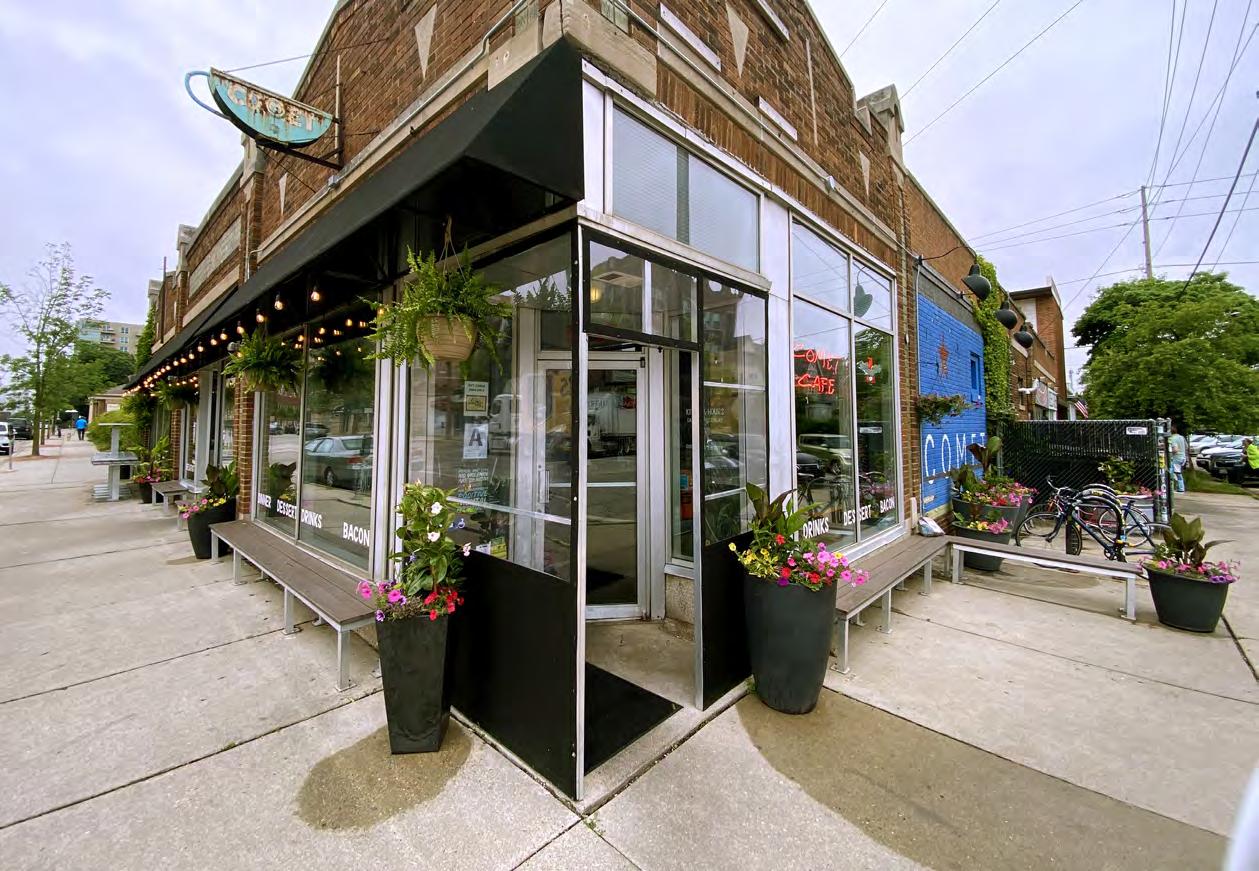
Visitors to the “new” Comet Cafe may notice there have been some changes from those days long past, which shouldn’t really be a surprise in any restaurant that’s been around for more than 20 years. The casual laid back vibe is still very much present, and depending on when you go, there is still going to be a wait for a table. But as any veteran Comet diner will tell you, the food is worth the wait. On a recent visit, that meant about 20 minutes to chill on a bench outside and enjoy the urban landscape. When our table was available, we were seated quickly, and service was fast and friendly.
Begin your meal with Comet’s version of Poutine ($16), a generous portion of hand-cut fries topped with creamy cheese curds, fried pork belly, scallions, and rich beer gravy. Or try the Vegan Chili “Cheese” Fries ($15) featuring those delicious hand-cut fries again, topped with Comet’s housemade veggie chili, vegan “cheese” sauce and scallions.
Photo by Michael Burmesch.
22 | SHEPHERD EXPRESS FOOD & DRINK
Photo courtesy of Comet Cafe.
REMEMBER THE MEATLOAF?


Long-time fans of Comet will be thrilled to see that the bacon-wrapped Meatloaf with Beer Gravy ($18) made famous after a visit by celebrity chef, Guy Fieri, is still on the menu. The dish features the aforementioned meatloaf wrapped in bacon, topped with creamy chive mashed potatoes, grilled tomatoes and onions, served on top of a piece of salted rye bread with gravy over all. Another Comet classic dish that’s not to be missed, is the Compact Turkey Dinner ($17), which consists of three beer battered balls stuffed with turkey, cheesy mashed potatoes, and stuffing that have been fried and covered with gravy and served with the veggie of the day.
Before 3 p.m., breakfast on weekdays or brunch on weekends is a solid choice at Comet Cafe. Standouts include a fantastic Biscuits and Gravy ($15), made with freshly baked biscuits, filling sausage gravy, and two farm fresh farm eggs. The Bacon Cakes ($8 for one, $14 for two) which are properly fluffy pancakes filled with bacon are also quite good. And, for those who prefer a meatless option, try the Tofu Scramble ($13) which is a pleasing blend of tofu, bell peppers, artichoke hearts, spinach, veggie sausage, and hashbrowns served with toast.
The menu is rounded out with excellent sandwich options ($12-$16), salads ($12-$15), and dynamite pies for dessert ($7 - $7.50 a slice) made in their sister restaurant Honey Pie.


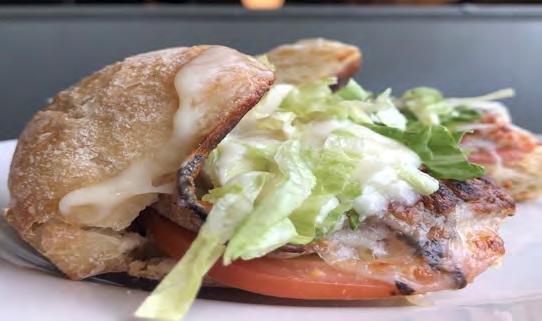

COMET CAFE 1947 N. Farwell Avenue (414) 509-6028 www.thecometcafe.com $$-$$$
Susan Harpt Grimes is a veteran Milwaukee writer and a longtime Shepherd Express contributor.
Photo courtesy of Comet Cafe.
JULY 2023 | 23
Photos courtesy of Comet Cafe.
Savage Pesto
BY ARI LEVAUX
For those who haven’t yet acquired a taste for them, turning these greens into pesto is a great way to explore the wild side of greens.
Pesto is a process as much as a recipe. It’s a method of turning greens into an Italian-style green paste by grinding them with garlic, oil, nuts and cheese. These ingredients, also robust of flavor, can turn the strength of wild flavors into an asset.
Every region will have its own array of edible and nutritious spring greens. I found nettles growing in a little wild spot near my house, and dandelions in the garden. So I decided to make dandelion and nettle pesto. Dandelions are bitter like a fine IPA, but the pesto they make isn’t, because it’s covered up by the other ingredients. Nettles have a fruity, metallic flavor. And thanks to their prickly nature it’s best to harvest nettles with scissors and gloves. The stingers wilt when cooked – and in the case of pesto, when spun in the blender.
This wild pesto is in the spirit of the old fashioned “spring tonic.” A spring tonic is a mix of wild plant parts traditionally gathered at the end of winter in many rural parts of America. Back in the day, our pioneering and homesteading predecessors survived the winter on rations that would dwindle to the likes of flour, bacon, potatoes and sugar. When winter finally broke after months indoors on a white, greasy diet, the first hunt of the year for vitamin-rich green shoots was an awakening for the mind, body and belly.

Foraging helps build the relationship between you and your landscape. You look differently at a place when you forage it, and see the landscape more closely, differently, and more deeply. You begin to think ecologically, keeping track of north, south, elevation. You find yourself having thoughts like, “I’m going to be down in the valley this afternoon, where the dandelions will be further along and bigger; I should grab some.” Whether or not you find anything to eat, the very act of exploring vacant lots, river bottoms, random woodlands and other spots will be a reward in itself.
The bitter nature of wild plants is the flavor of both medicine and poison. But if you’ve done your research properly, the bitterness should all be medicinal. Or at the very least, nutritional; wild plants tend to be more nutrient-dense than their domestic counterparts.
Just remember, every would-be forager must assess the grounds at their disposal and strategize accordingly. Always do your harvesting away from any trail, and don’t ever wipe out a location, so that the patch can recover. And if you are lucky enough to have a backyard, explore every square inch. Avoid foraging in dog parks, toxic waste dumps, and close to roads. Just as importantly, remember that the food we gather has not been vetted for edibility like grocery store food. Make sure you know what it is that you are gathering. Nowadays there are apps that can identify plants, or if you’re old fashioned you can use a book. Either way, foraging in the modern age is still foraging. And the wild foods of spring are just as wild as ever.
WILD PESTO
Pesto is one of the tastier ways to consume any strong-flavored green plant. Today’s pesto is made with dandelion and nettles, which makes a thick, aromatic pesto. Feel free to substitute any number of wild greens or weeds, like lambsquarter, watercress or chickweed, or a mixture of whatever you think will go well together. You can also add basil, parsley and other domestic herbs.
8 SERVINGS
• 2 tablespoons chopped garlic
• 1 teaspoon salt
• 1 cup olive oil
• 1/2 cup almonds (or pine nuts)
• ½ cup grated parmesan or romano cheese
• Zest of a lemon, and 2 tablespoons of juice
• 4 cup chopped dandelion greens, loosely packed, spotlessly clean
• 5 three-inch nettle tips (or other greens)
Add the garlic, salt, oil, almonds, cheese, lemon juice and zest to the blender and turn them into a thin, homogenous (and delicious) solution. Carefully add the greens to the pesto, a few at a time, until they too are part of the smooth, green paste.
Serve your weed pesto tossed on piping hot noodles, which will cook the garlic just a tad. I like to stir in some sauteed greens too, for an extra reminder of why we are here.
Refrigerate the leftovers for up to a week or freeze to store for the year.
Photo by Ari LeVaux.
FOOD & DRINK FLASH IN THE PAN 24 | SHEPHERD EXPRESS
Ari LeVaux has written about food for The Atlantic Online, Outside Online and Alternet.

The Brewers at Midseason The Brewers at Midseason
BY KYLE LOBNER
The Brewers will almost certainly find themselves in position to add talent at the upcoming MLB trade deadline, but their past experiences on that front could impact their thinking about what happens next.
Organizational depth has been a real challenge for the Brewers in the first half of the season, where injuries have forced them to consider nearly every option to fill their roster. In 2011, when the Brewers won the National League Central, they used just six starting pitchers all season. In 2023 they used nine in their first 50 games. They’ve had similar challenges in the outfield and the bullpen, where injuries and ineffectiveness have forced them to cycle through their options.
The Brewers’ franchise record for players used in a season is 61, set on their way to an NL Central-winning season in 2021. They’ve been one of baseball’s most successful teams when it comes to churning through their depth to find contributors. They might use more than 61 players in 2023, but some of the options they might have otherwise considered have been traded to other organizations.
In early June right-handed pitcher Reese Olson made his MLB debut with the Tigers in grand fashion, as the 23-yearold pitched five hitless innings. The Brewers drafted Olson in the 13th round in 2018 and if he was still in the organization, he might have been a candidate to fill one of this season’s vacancies. Instead, in July of 2021 they traded him to the Tigers for reliever Daniel Norris. Norris made 18 appearances for the Brewers down the stretch that season and posted a 6.64 ERA.
TRADING MINOR LEAGUERS


All told, the Brewers have traded minor leaguers for bullpen help at the trade deadline in nine different transactions over the last six seasons. Some of those trades have worked out, like the 2017 deal where the Brewers sent reliever Tayler Scott to the Rangers and reunited with future All Star reliever Jeremy Jeffress. In nearly every other case, however, the relievers the Brewers have brought on board have had abbreviated stays in Milwaukee and many of them have not pitched well during their short tenure.
Meanwhile, six of the nine minor leaguers the Brewers traded away in those transactions have gone on to play in the major leagues with other teams. Two others, pitcher Antoine Kelly and outfielder Tristan Peters, are among the top prospects in their new organizations. Like Olson, many of these players might have been candidates to fill the holes on this season’s MLB roster if they hadn’t been dealt for short-term solutions in prior years.
The National League Central hasn’t turned out the way anyone expected this season, and that’s going to leave several teams in a position to “go for it” down the stretch. Despite extended stretches where they’ve struggled this season, the Brewers might be in the best position among a weak group to make a run at the postseason. As the trade deadline approaches, they’ll almost certainly face pressure to add pieces and strengthen their opportunity to play meaningful baseball in October.
It’s lso true, however, that this Brewers team is in a good position to reload and try again in 2024. Corbin Burnes, Brandon Woodruff, Willy Adames, Christian Yelich, Rowdy Tellez, Luis Urías, Devin Williams and Freddy Peralta are all under team control for at least one more season, creating the possibility that the Brewers could assemble a team around them that is legitimately great and not just good enough. Many of those players are also due significant raises, however, so building around this core would require a greater payroll commitment.
After a challenging and at times frustrating first half, the Brewers are perhaps fortunate to still have all their options on the table at the trade deadline. The choices they make in the short term, however, may have an impact that lasts beyond this year’s stretch run.
Photo by Free art director/Getty Images.
Kyle Lobner writes the weekly On Deck Circle column for shepherdexpress.com.
26 | SHEPHERD EXPRESS SPECIAL SPORTS SPOTLIGHT | SPONSORED BY POTAWATOMI SPORTSBOOK

Protect Your Pets from Summer Pests
BY CARRIE MARBLE, OWNER BARK N’ SCRATCH OUTPOST, AND CALEY


Summer weather is finally here. Time to pack up your favorite pet and hit the great outdoors. As pet owners we know with summer activities comes the need for flea and tick prevention. It seems every year the pests are getting worse. This year is no different. Reports started coming in during May that after being outdoors pet owners are finding several ticks between toes. Not one tick, several ticks between each toe.
Many pet owners are unaware that using synthetic chemicals for parasite control can have an adverse impact on their pet’s body's beneficial microbiome and over time parasites can become resistant, requiring ever stronger doses which can serve to increase the risk of adverse side effects. Applications of herbal products to combat parasites is gaining greater consideration as an alternative approach. Before you reach for a synthetic chemical-based parasite control product, take a moment to look at another options
Wondercide® is proven to work without the conventional ingredients. Their lineup of plant-powered sprays, spot ons, collars, and shampoos harness the power of nature to do the job. Lab-tested to protect your pet from fleas, ticks, and mosquitoes.
Wondercide® is 99% effective at preventing fleas from hatching into larvae, making it a highly effective flea life cycle control solution for pets and homes.
Wondercide® products stand out from other natural flea and tick remedies because unlike many other products Wondercide® uses only 100% active ingredients and no water. Lab testing confirmed that Wondercide® cide products can quickly and efficiently kill and repel bed bugs, ticks, fleas and mosquitoes




Wondercide® is proven to work and easy to use. Their plant-powered flea-and-tick products for your pets, home and yard replace conventional flea-and-tick protection.
Safe for dogs and cats of all ages when used as directed. Products loved by people, pets, and pollinators are in stock for pick up or delivery today. Stop in with any questions you may have about any flea and tick products.
Content sponsored by Bark n’ Scratch Outpost. Locally owned since 2006, Carrie, Michael and staff are dedicated to educating pet owners about the importance of their pet’s diet. Bark n’ Scratch Outpost is located at 5835 W. Bluemound Rd, Milwaukee, WI 53213
Photos by epantha/Getty Images.
28 | SHEPHERD EXPRESS SPECIAL PETS | SPONSORED BY TAILS N' TRAILS PETS LLC





JULY 2023 | 29
WHAT’S YOUR POISON?
ENVIRONMENTAL HEALTH PART 2—DETOXING YOUR BODY
BY KATHERINE BAYLISS
When Sally came to me to help with her GI symptoms, she also indicated that she had become extremely sensitive to medications and was very nervous about an upcoming surgical procedure. She hadn’t always been so sensitive. She also noticed she could no longer enjoy even a single glass of wine without feeling awful the next day. This was a red flag for me that her detox pathways were overloaded.
The last column, “Environmental Health Part 1” (April Shepherd Express) brought attention to the risk we all face from the pervasive toxicants in our environment, most of which escape our attention. Many common modern day health issues are linked to these toxic insults our bodies accumulate over time with most of us carrying a significant toxin overload. Proactively eliminating toxin exposure where possible is the first crucial step. In part 2, Environmental Health Part 2—Detoxing Your Body we will explore what else might be done to support your body’s natural capacity to rid your body of toxins.
Toxins move through enzymatic pathways and physiologic processes occurring within cells and organs, ultimately leaving the body through sweat, urine and poop. When overloaded, we naturally sequester toxins, mostly in fat (including our brain). A detox protocol is designed to proactively support these pathways, pushing toxins out. There is a strategy; mobilizing sequestered toxins prior to doing foundational work, or going too fast, may overwhelm your system, thwarting your efforts and causing significant unpleasant symptoms.
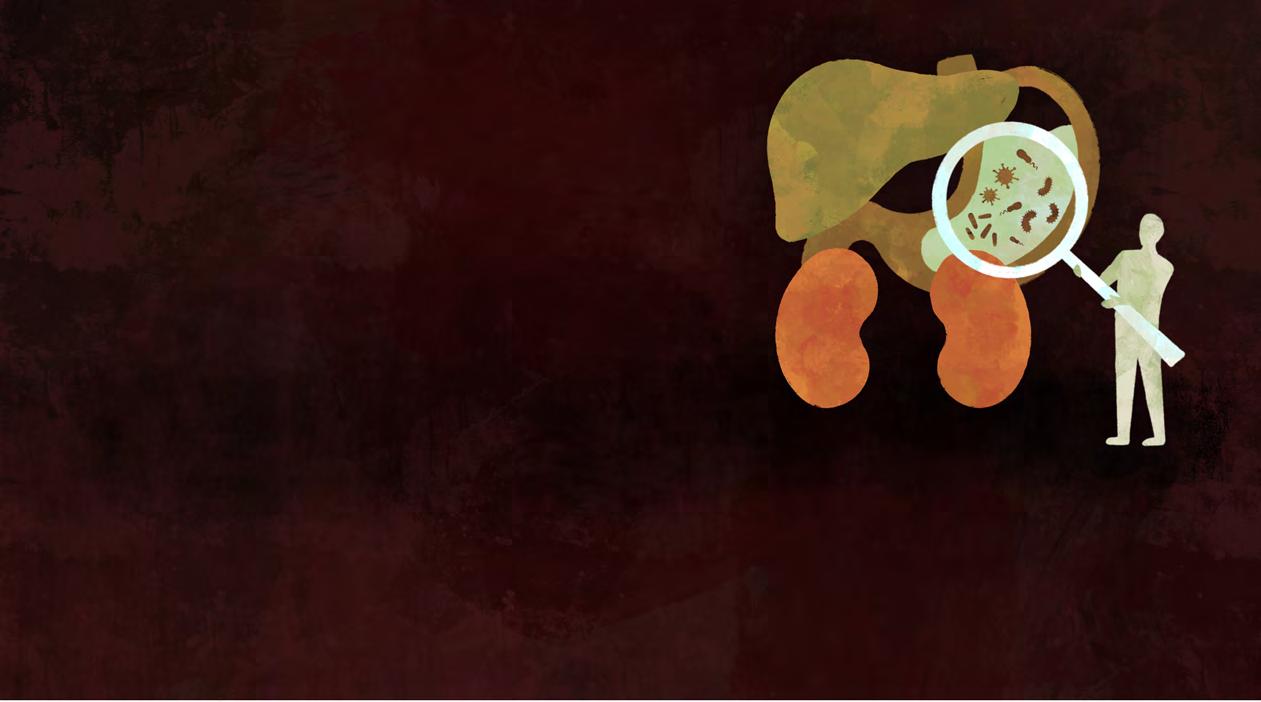
The following represents broad strokes in the steps involved in an optimal approach to detoxing.
1. Eliminate toxins going “in.” When you start moving toxins around the body during a detox effort—adding more can overwhelm the system and make you feel sick. For example, avoid alcohol during this process.
2. Eat a clean, organic, nutrient dense diet full of many fruits and vegetables rich in vitamins, minerals, fiber and antioxidants. Nutrition is key to supporting detox pathway enzymes and organs. Sometimes we add specific nutrient supplements.
3. Optimize gut health. Balance the gut microbiome and make sure you are pooping! (see previous columns on
gut health). A surprising number of people have chronic constipation and don’t realize that they should have 1-3 BMs per day. If you don’t, you risk reabsorbing toxins that your body is trying to eliminate through your stool.
4. Support the liver. The liver does the heavy lifting passing toxins from cells into the bile and ultimately out through the stool. Various compounds either from foods or supplements can push these enzymatic pathways and improve bile flow. This can be a key step.
5. Support the kidneys, another important organ for toxin elimination. Hydration matters. Specific foods and supplements targeted at the kidneys can also help.
6. Sweat! Sauna and exercise help move toxins out through our sweat.
7. Move lymph. Lymphatics also help carry toxins out and drainage can be enhanced with lymphatic massage and dry brushing.
While going through a protocol such as this may be challenging, modifications can be made to move forward more gradually. Most people will benefit from the guidance of a functional medicine physician or skilled functional nutritionist to fill in the details of such a protocol. Another great resource for more information is Joseph Pizzorno’s book The Toxin Solution.
Working with Sally, we incorporated the first three steps while addressing her GI symptoms. We then employed a fairly simple protocol to further heal her detox pathways. She has been diligent about her diet and avoiding environmental toxins. She sailed through her surgery and happily reports that she can once again enjoy an occasional glass of wine with friends.
While what I have outlined might suggest a one-time event, for anyone that is serious about vibrant health, ongoing intermittent detox support becomes a way of life.
Katherine Bayliss, MD, a Milwaukee native, practiced in conventional medicine as a pathologist for 25 years. She now lives her passion, helping others through the more holistic functional medicine model.
Illustration by Ali Bachmann.
30 | SHEPHERD EXPRESS SPECIAL HEALTH & WELLNESS TRUE HEALTH



JULY 2023 | 31
The Mind of a Misogynist SPECIAL HEALTH & WELLNESS OUT OF MY MIND
At first, Alex was a bit of a mystery to me. Psychotherapists sometimes call a client’s reason for seeking counseling their “ticket,” and his was a mixed bag of depression, agitation and loneliness. But I also sensed some other back story. A 20-something just out of grad school and working his first professional job, he complained of not fitting in with others despite wanting to. Working off a hunch, I inquired.
“Have you ever had a serious girlfriend?”
Alex’s reaction was telling. His brow furrowed as he looked away, his body tensed, and his breathing quickened.
“No, not really,” he stated. “I don’t connect well with girls.”
In fact, he didn’t connect much at all. He’d never had a girlfriend, his overtures were often declined, what dates he garnered were one-offs, and lovemaking occurred only in his fantasies. What’s more, he often felt spurned by females. When discussing this, Alex’s tone shifted markedly, becoming increasingly acrimonious. As his complaints and bitterness toward women gradually emerged, the man’s mindset became clear. He harbored an “incel complex.” This term does not refer to a formal psychiatric diagnosis, but probably should.
BLAMING WOMEN?
Research at Michigan State University examined individuals like Alex, hoping to discern what plagues them and why. They determined these persons are celibate but not by choice, are predominantly heterosexual males, usually late teens into their 30s, and feel cut off from emotional and sexual intimacy. However, the most salient feature of the incel mindset is to blame women for their predicament. They feel slighted and snubbed by females, perceiving them as cold-hearted tormentors.
Although Alex didn’t use the following terminology, it encapsulated his posture: “Only women can give me what I want and deserve, and, out of spite, they withhold it.” Notice the term “deserve,” which he uttered repeatedly in reference to his own wants. These men believe themselves entitled to a woman’s graces, and when those are not forthcoming, they also feel entitled to righteous indignation and, in some instances, retribution. Incel complex fosters both misogyny and, in some, physical violence, including sexual assault.
How does this condition emerge? We don’t have many answers yet, but, as with most psychological dysfunction, the influences are probably many. It’s possible these men have common
BY PHILIP CHARD
personality traits or interpersonal styles that are off-putting to most women. Many also disclose not fitting in well with people in general, and some self-report being, as we say, on the spectrum. However, they do connect well with one group—their own kind. There are online chat forums for guys with this complex, not to change their mindset but to reinforce it. They also clearly possess a strong sense of entitlement. To them, the world—in this case, the female world—owes them.
I’m not suggesting these fellows are not suffering. They are. Their experience of aloneness, alienation and deprivation is very real and painful. Russian novelist, Fyodor Dostoevsky, said it best in defining hell as “the suffering of being unable to love.” What makes it hard to feel compassion for those like Alex is their insistence on blaming their misery on that which they desire. I once worked with a man with a similar pedigree except for one salient difference. He decided to take responsibility for his awkwardness with women and worked diligently on improving his emotional intelligence. Which is the only viable strategy for those with this dysfunction. First, the person must look in the mirror and believe they are seeing the source of and solution to their problem. Absent that, the odds for change are slim.
 Photo by Davizro/Getty Images.
Photo by Davizro/Getty Images.
The Mind of a Misogynist 32 | SHEPHERD EXPRESS
Which is unsettling because, in our society, women know they are prey to men with incel complex, among others. They may not know it in those terms, but they experience it in their interactions. The paucity of behavioral research focused on incel complex is testament to the insidious sexism in our culture. Almost half of women have suffered sexual violence in some form, and even more endure the misogyny that permeates homes and workplaces. Yet, while men with this complex are among the primary sources of their victimization, the causes and potential treatments for this condition garner little attention.
It’s time we figure this out.



Philip Chard is a psychotherapist and author with a focus on lasting behavior change, emotional healing and adaptation to health challenges. For more, visit philipchard.com.

JULY 2023 | 33
When a Partner Doesn’t Take Your Boundaries Seriously
BY LAURA ANNE HAAVE, MPH


34 | SHEPHERD EXPRESS SPECIAL HEALTH & WELLNESS SEXPRESS
At a national peer education conference, I served as a panelist for a session called “Ask the Sexperts,” where students could anonymously submit any and all questions about sex-related topics. Since I do these kinds of workshops on college campuses fairly frequently, it’s interesting to note trends in the types of questions received. This time, as usual, the largest number of questions on any single topic concerned orgasm, especially from women who hadn’t experienced one yet. Think of the anxiety that could be relieved if we taught about the clitoris and basic human sexual response cycle in every high school health class! We also received the typical smattering of inquiries about the G-spot, HPV, herpes and HIV, subjects about which our knowledge is continually evolving and about which there exists a lot of misinformation. I was surprised at the lack of questions about anal sex, which is usually a pretty hot topic.
I was most struck, however, by questions about sexual communication. We are still doing a poor job of getting people to talk openly about sex and not make assumptions about other people based on their identity or past behavior. The hardest questions to answer are the ones about relationships and negotiating sexual boundaries, because there are no quick-and-easy solutions that apply universally. Several students chose to follow up with me after the Q&A was over to clarify their questions or get more specific information, because it’s almost impossible to confine a sexual communication question to the simple 3-by-5 index cards that we used to collect them.
One student I talked to had followed all the “rules” that are typically suggested about clearly defining her own sexual values and boundaries before getting into a relationship and then communicating those boundaries to a potential partner before getting involved in a relationship. Love it! Her partner appeared to understand those boundaries and they had a mutual agreement about what they would and wouldn’t do sexually.
However, over time, some “boundary creep” appeared. I’ve heard about this from other people as well. Either your partner assumed that you would change your mind about a particular type of sex (“Oh, wait—you meant ‘never’ when you said ‘never’?”) or, in the flush of a new relationship, underestimated the importance of a particular type of sex to them. Perspectives can change when a person hasn’t had a kind of sex they like in a year or more. And then subtle, passive-aggressive pressure can appear, perhaps in the form of offhand comments or questions or even through trying to take things in a new direction during sex without discussing it first.

This can be frustrating to both partners, especially the one who thought that she or he had been upfront and clear about boundaries at the beginning. To me, this emphasizes the fact that sexual negotiation is an ongoing dialogue, not a one-time conversation. People change and relationships are all about knowing when to compromise so that both people’s needs are reasonably taken care of, and knowing when a compromise would require you to abandon too much of yourself.

I suggested to this student that she bring up the passive-aggressive behavior she was seeing in a direct but non-confrontational way, simply stating what she was witnessing and asking her partner what was going on. It seemed time to reopen the discussion, acknowledge that relationships can be difficult, and see how both people felt about the original agreement. Perhaps talking alone can resolve the feelings of frustration, perhaps a new compromise agreement can be reached, or perhaps the two will realize that their values are not compatible and move on. I would consider any of these outcomes a success as long as both people feel that they have maintained their integrity as sexual beings.
Laura Anne Haave has a master’s degree in public health and has worked as a sexuality educator. She is the owner of Tool Shed, Milwaukee’s mission-drive sex toy shop.

JULY 2023 | 35
Photo by 3DSculptor/Getty Images.


Kelly’s Greens Elevates the Cannabis Edibles Market

In recent years, creative bakers and chefs have taken the cannabis edibles concept to gourmet heights. Locally, Racine native Erin Kelly, through her business, Kelly’s Green’s, features scratch-made bakery such as cookies, truffles and brownies, along with gummies and dog treats infused with cannabidiol (CBD).
She also makes a line of items with delta-8 and delta-9, the slightly less potent tetrahydrocannabinol (THC) compounds of the cannabis plant that are legal in most states, thanks to an oversight in the 2018 federal Farm Bill.
Kelly sells her cannabis treats through pop-ups at area fairs and festivals. She will open a CBD boutique later this summer at 8932 W. North Ave., Wauwatosa. Kelly, who now lives in Wauwatosa, is planning an inviting space for people curious about cannabis. She’ll offer classes on how to make cannabis products, along with a high tea class where people can sample and learn about CBD, delta-8 and delta -9.
CLOSE TO HOME
BY SHEILA JULSON
“My heart was set on being close to home,” says Kelly. Her first few events were in partnership with Ray’s Wine & Spirits, located next to her soon-to-be store. Kelly’s building was vacant for several years and was completely gutted, leaving a blank canvas for her vision. She plans to remove the bay windows from the front of the building and replace them with French doors that will open onto a patio.
An indoor seating area will feature an oversized green velvet sofa, chairs, a commercial kitchen, and an area for product. A curved bar will have brass rails, “and of course, green bar stools, because, what else would we have?” Kelly laughs, referencing the Irish theme of her business. At the bar, people can enjoy non-alcoholic drinks, coffee or tea infused with the cannabis of their choice.
Kelly is working with Wauwatosa-based architect Ed Haydin of Haydin Thacker Architecture, and Andy Braatz of Braatz Building, to design and build out the space.
38 | SHEPHERD EXPRESS SPECIAL HEALTH & WELLNESS CANNABIS
Photos by Sarah Mueller Photography, courtesy Kelly’s Greens.



JULY 2023 | 39
THE ART OF EDIBLES
Kelly has always loved to bake. She worked at O&H Danish Bakery while growing up. She later worked as vice president of sales and marketing for a regional health plan but lost her corporate job during the pandemic.
As one who’s always been “canna-curious,” along with being inspired by a previous vacation to Amsterdam, Kelly began crafting artisan style CBD edibles that became a hit with friends and family. “In states where cannabis is fully legal, I struggled to find a cannabis cookie that was worth the calories. Most were stale or dry. Even in Amsterdam, where I thought there would be amazing edibles, I couldn’t find much. There, it’s more about smoking.”
To further her cannabis education, Kelly completed Saint Louis University’s cannabis science and operations certification program. She also worked at American Shaman’s Waukesha location. She learned to craft candies and truffles while working at Niemann's Candies, in Wauwatosa.
Popular Kelly’s Greens treats include Niemann’s famous toffee with brown butter cookie, made with almond butter and topped with chocolate and sliced almonds. It contains 20 mg of CBD. It was made through a collaboration with Niemann’s.


COOKIES BY THE DOZEN
Other CBD cookies, which are sold by the dozen, include choices such as dark chocolate chunk walnut with sea salt, and ginger spice. Delta-8 edibles consist of frosted sugar cookies with jimmies, the cosmic brownie with chocolate ganache, dark chocolate truffles, peanut butter balls, and white chocolate pistachio butter truffles. All contain 20 milligrams of delta-8.

Kelly makes custom items for special events. She recently made Pride Cake Pops for Pridefest. She will expand her line to include vegan options. She uses local ingredients whenever possible and sources cannabis extracts from Pine Hill Farms, in Watertown. Kelly’s Greens uses full spectrum CBD, which includes all the cannabinoids and terpenes from the plant.
The process for infusing cannabinoids into the items varies depending on the product. “For cookies, extraction is done old-school, where you toast flower and use butter to extract the medicine. Beverages are dosed out appropriately by weight or by syringe, and there’s water-soluble or oil-based products,” she explains. “We like to work with things that complement the flavor of our treats.”
Although the store’s not yet open, you can find Kelly’s Greens products online, at 600 East Café, Ray’s Wine & Spirits and at pop-ups throughout the summer; see facebook.com/kellysgreenswi or instagram.com/kellys_greens for schedules.
“My edibles are made small batch, with love and lots of cannabis!” Kelly concludes.
For more information, visit kellysgreens.com.
40 | SHEPHERD EXPRESS SPECIAL HEALTH & WELLNESS CANNABIS
Sheila Julson is a Milwaukee writer and author of the Eat Drink column for shepherdexpress.com.
Photos by Sarah Mueller Photography, courtesy Kelly’s Greens.
Photos by Sarah Mueller Photography, courtesy Kelly’s Greens.
Learn to Manage Personal Debt
BY MICHAEL MUCKIAN
William Shakespeare is called upon for many educated quotes, but only one deals with personal finance. In Act 1, Scene 3 of Hamlet, Polonius bids farewell to his son Laertes, saying:
Neither a borrower nor a lender be, for loan oft loses both itself and friend.
Chances are Polonius never tried to buy a house or, this being the 17th century, certainly not a car, a luxury vacation, an advanced education for Laertes, or any of many modern-day conveniences. Polonius certainly offers sound advice, but advice that’s not practical in today’s world.
These days, everyone who can do so finds themselves borrowing for any of the above instances and more. The one thing too many of those borrowers, especially younger ones, learn too late is how to manage their debt.

According to bankrate.com, in 2022 most Americans carried at least one credit card around with them with an average card balance of $5,589. In fact, the average American’s debt is $96,371. That’s a lot of unsecured debt on which to pay interest. By the end of 2022, the Federal Reserve Bank of New York reported that American credit card debt alone totaled $986 billion. Given the economy, that amount likely won’t be declining anytime soon.
So how do you manage debt? Good financial planning and strict budgeting are the cornerstones of debt management. Your goal, ultimately, should be to retire any and all debt so you can lead a more comfortable and secure life. The

JULY 2023 | 41
Photo by Rawpixel/Getty Images.
less you owe, the more money you have to spend. The more you owe, the less money you have to spend, since a good portion of what you do have will be dedicated to servicing pre-existing debt.
DISCIPLINE PAYS OFF
How do you manage the debt you carry? Most people follow the do-it-yourself method, dedicating a portion of their income to paying down debt. You have be disciplined, but the discipline pays off by earning you a better credit score which, in turn, can result in lower interest rates when you borrow for big-ticket purchases like a home mortgage.
Some people use credit counselors, who are paid to help those struggling with debt better manage their repayment processes. You will be sharing your financial woes with a stranger, but one trained to help people like you achieve their debt-free goals. They will set a timeline, help you estimate a payment schedule, and offer you a plan to take you to your goal.

However, some debt management plans require payment to the agency, which is then distributed to various creditors according to the plan they establish for you. This methodology can and does work, but you are contractually obligated to follow the plan, which means less access to your own money.
Before you go that far, here are some techniques you can try for yourself:
Pay more than the minimum amount owed. You will retire debt sooner while exponentially improving your credit score.
• Try a “Debt Snowball,” in which you pay off your smallest debt first, consigning the funds you had paid to that creditor to paying more on the next smallest debt. As this process snowballs” you end up paying more to each creditor up the line until most if not all of your debt is retired.
• Refinance existing debt at a lower interest. A debt consolidation loan may be your best bet here, reducing the number of payments while ultimately costing you less in interest.
• Commit your unexpected windfalls to paying off debt. These include tax returns, inheritances and sources of cash not currently in your budget. You may miss a vacation or two, but you will more quickly satisfy your loan.
Finally re-examine your household budget to see if there are ways you can realign cash flow to commit more to paying down debt. (Periodically examining your budget is a good idea anyway.)
Whatever method you choose, you will retire debt more quickly and start keeping more of the money that you earn. Polonius would be proud of you.
Photo by M-Production/Getty Images.
42 | SHEPHERD EXPRESS SPECIAL PERSONAL FINANCE
Michael Muckian was the banking and finance writer for the Milwaukee Business Journal and is the author of The Complete Idiot’s Guide to Financing and Accounting and The One-Day MBA in Finance and Accounting

Three Summer Loves
BY GAETANO MARANGELLI
These are three of my summer favorites. Three antidotes for the langours of season. Three anecdotes about the energy of its heat. Three summer loves.
AFFOGATO
We were four friends in the middle of Italy in the middle of summer. A painter from Calabria, a movie editor from Cologne, a public policy scholar from Baltimore and me. The colors of our skin were porcelain and ebony, honey and almond. And we were all in desperate need of an affogato
As we crossed the threshold of a sleepy café, its barista spoke out loud to himself. “I quattro mondi.”
The four worlds. That was his commentary about my friends and me. About our four disparate colors.
The four worlds is also my commentary about affogato
L’affogato al caffè is a beverage as much as it’s a dessert. It’s vanilla gelato in a bath of espresso. Its magic is in the
metamorphosis of its identity. A dessert sauced with coffee turns into its own creamy chaser. The sweet ice cream and bitter coffee enhance each other. Like the best of friends, they meet in the middle. Its porcelain and ebony turn into honey and almond.
L’AFFOGATO AL CAFFÈ
Ingredients
• 1 or 2 shots (1 or 2 ounces) of hot espresso

• 1/4 or 1/2 cup of cold vanilla gelato. (If you’re using one shot of espresso, then use 1/4 cup of gelato. If two shots, then 1/2 cup.)
Method
Make the espresso, then scoop the cold gelato into a small, shallow bowl, glass or cup. Slowly pour the hot espresso in a thin stream directly over the gelato, draping the entire surface of the scoop with an even layer of coffee.
 Photo by Rauf Omer Ince/Getty Images.
AFFOGATO
Photo by Rauf Omer Ince/Getty Images.
AFFOGATO
44 | SHEPHERD EXPRESS SPECIAL SUMMER DRINK | SPONSORED BY DISCOUNT LIQUOR


JULY 2023 | 45
SPARKLING WINE AS A LUXE SPORTS DRINK
It was a hot summer day. I was back in the apartment after a ten-kilometer run. My face was in the fridge. I was thirsty, but I didn’t want water. And there it was, looking at me.
“No, I can’t,” I whispered to myself.
“But it’s three in the afternoon,” it whispered back. “And you’re off today.”
So I drank it then and there. A half-bottle of brut non-vintage champagne as if it were a sports drink.
Maybe it was the measure of my thirst, or the physiological effect of heat on my palate, or the endorphins coursing through my nervous system, but drinking that drink of champagne was an out-of-body experience.
“I have to do this again,” I whispered to myself.
And I did. I have. On hot summer days after cardiovascular activity with all sorts of good sparkling wines. And every experience is like the first. The sparkling wine explodes across my palate. It slakes my thirst. It invigorates my body. It makes me think of sparkling wine as a luxe sports drink.
KÖLSCH
This one isn’t fair of me, but I’m going to tell you about it anyway. The best summer drink of all is Kölsch.
The two primary styles of beer are ales and lagers. Ales are made with yeasts which ferment at warm temperatures.

Lagers are made with yeasts which ferment at cold temperatures. Ales are conditioned–which is to say, carbonated–at warm temperatures. Lagers are conditioned at cold temperatures. Kölsch is a hybrid style of beer. It’s brewed at warm temperatures like an ale, but conditioned at cold temperatures like a lager, which yields a beer with the best qualities of both ales and lagers.
Kölsch has a straw color, with lightly fruity, yeasty aromas and flavors and a light, hoppy bitterness. It’s brewed with light barley malt and has an alcohol by volume (ABV) of about 4.8%.

Why is recommending Kölsch to you not fair of me?
Because Kölsch resists the demands of the North American market. Kölsch is a delicate style of beer which is best drunk as fresh as possible, which means it’s best made locally. It’s damaged by brewers over-hopping beer. It’s corrupted by the unpredictability of storage at warehouses and beer shops, as well as by the varying quality of barroom tap lines.
The Kölsch occupying the shelves of my refrigerator is made by two brothers of German descent in a Pewaukee basement. And they don’t sell their Kölsch. But at every beer shop and barroom I visit this summer, I’ll look for a good, honest, local Kölsch.
Gaetano Marangelli is a sommelier and playwright. He was the managing director of a wine import and distribution company in New York and beverage director for restaurants and retailers in New York and Chicago before moving to Wauwatosa.
KÖLSCH 46 | SHEPHERD EXPRESS SPECIAL SUMMER DRINK | SPONSORED BY DISCOUNT LIQUOR
Photo by frantic00/Getty Images.
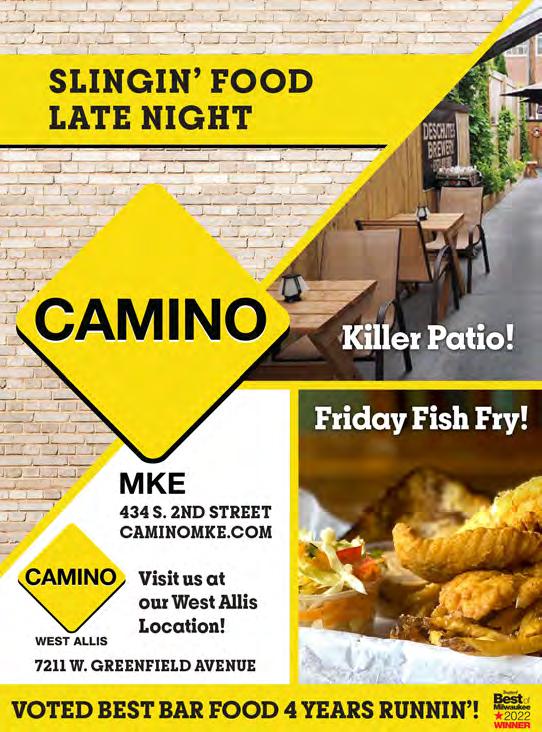


JULY 2023 | 47
History is Brewing at Old World Wisconsin
BY MICHAEL MUCKIAN
hose who fail to learn from the past are doomed to relive it, or so the saying goes. But for some, such repetition is a matter of choice and not always negative.

Consider Dan Carey. The craft brewer who, with his wife Deb owns New Glarus Brewing Co., learned a lesson in historic brewing at Old World Wisconsin in the mid-‘90s that changed the fortunes of his company.


Traveling through the Waukesha County open-air museum of state history and culture owned and operated Wisconsin Historical Society, the Carey family happened upon a recreation of a German farmhouse, complete with a kettle of beer covered with cheesecloth bubbling on the kitchen stove. The brewmaster paused over the tableau, wondering what farmhouse brewing in the mid-19th century was like, what ingredients the pioneer brewers used and, most importantly, what such a beer would look and taste like. Carey’s creative wheels started turning.
As a result, Carey in 1997 introduced Spotted Cow, a farmhouse-style ale that has become New Glarus Brewing Co.’s flagship brand, largest seller, and in 2009 was voted the “Best Drink in Wisconsin” by Bon Apetit magazine. The Old World visit was Carey’s muse.




POPULAR ATTRACTION

Since then, Old World Wisconsin’s brewing program continued advancing and is now a popular attraction at the park, a collection of buildings that recreate various immigrant communities that helped settle the state. Along with agriculture and industry, brewing was and continues to be one of Wisconsin’s economic and cultural cornerstones, according to craft brewer Rob Novak, Old World’s Brewing Experience Coordinator.
“The brewhouse is really a stage,” says Novak, whose combined background in brewing and theater makes him an ideal director for Old World’s “museum brewery” experience.
“I call it the ‘brew barn’ because physically that’s what it is, with two big barn doors and no indoor climate control. Its secondary purpose is to serve as an exhibit space, bar space and event space.”
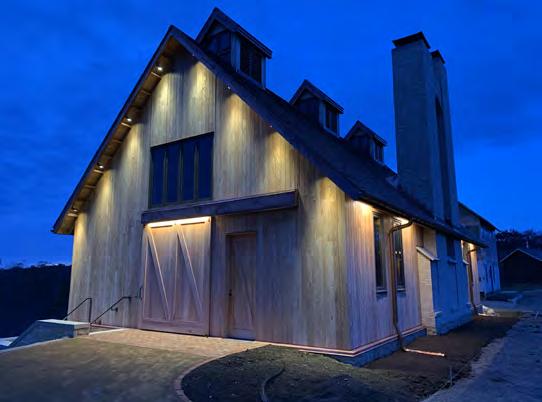

Images. 48 | SHEPHERD EXPRESS SPECIAL SUMMER DRINK | SPONSORED BY DISCOUNT LIQUOR
Photos Courtesy of Wisconsin Historical Society. Illustrations by Tim Czerniakowski. Woodgrain background by Vera
Atroshchanka/Getty
ROB NOVAK



JULY 2023 | 49
Novak and his team of volunteer brewers utilize mobile brewing equipment, much of it donated by The Museum of Beer and Brewing, a Milwaukee-based traveling museum of volunteer brewers that in 2017 first started the park’s brewing program. The current brew barn, completed in February 2022 and operating under Novak’s stewardship, further solidified Old World’s brewing commitment.

Most of the brewing gets done during the summer season, which runs from Wednesdays-Sundays, June 14-Aug. 27, with Spring and Fall weekend-only seasons before and after those dates. Novak and his team brew every day the museum is open, making a different 5-gallon batch of beer each time, a process that takes about 6 hours over an open flame. As a museum brewery, Old World is not allowed to sell its beer, but it does offer free limited samples to visitors who gather to watch the process. It also provides beer for occasional dining events held on the grounds.
One exception to the no-sell rule involves the occasional partnerships Novak strikes with licensed breweries. Deusterbeck’s Brewing Co., an actual farmhouse microbrewery in Elkhorn, is a popular partner which has featured Old World beers on tap. “Last year we brewed a summery saison with a spiciness and orange peel that we really liked, and our partnership with Deusterbeck’s allowed us to bring it to a larger market,” Novak says.
Old World brews roughly a barrel of beer each week, which totals about 31 gallons. At 100 batches per year, that means an annual output of 500 to 600 gallons before the park closes for the season on Sept. 24.

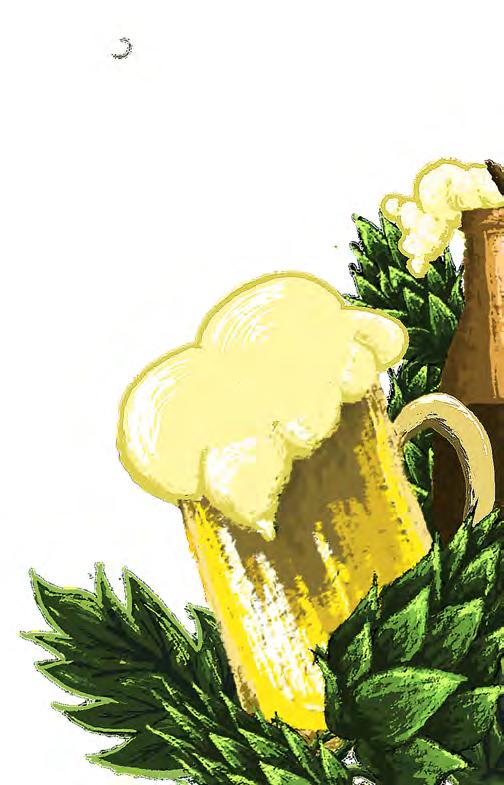
Certain aspects of brewing have changed significantly over the years, but at its heart brewing is still brewing and beer is still beer, the brewmaster says. Novak, who also has worked with Milwaukee-area breweries Draft & Vessel, Black Huskey Brewing, and Raised Grain Brewing Co., has learned a lot from brewing processes old and new.




“I’ve learned that the key is to pay attention to the process, the ingredients, the beer and the fermentation,” Novak says. “Brewing is an important part of our state and connects people in ways that are easy to see. And you can have a beer with just about anyone,” he adds. “Maybe there’s a key to humanity here.”
Michael Muckian was the banking and finance writer for the Milwaukee Business Journal and is the author of The Complete Idiot’s Guide to Financing and Accounting and The One-Day MBA in Finance and Accounting


50 | SHEPHERD EXPRESS SPECIAL SUMMER DRINK | SPONSORED BY DISCOUNT LIQUOR
Photos Courtesy of Wisconsin Historical Society. Illustrations by Tim Czerniakowski. Woodgrain background by Vera Atroshchanka/Getty Images.







JULY 2023 | 51
OUTDOOR DINING & DRINK


BEANS
& BARLEY
1901 E. North Ave.
Milwaukee
(414) 278-7878
Beansandbarley.com

A specialty store and restaurant located on Milwaukee's East Side. There’s a market with everything from groceries to gifts, an all-homemade deli with fresh specials every day, and a café that serves vegetarian and non-vegetarian options for breakfast, lunch, and dinner. They have a steady commitment to three principles: quality, value, and fun. Stop in and treat yourself to some real, good, food.

CAFÉ AT THE PLAZA
1007 N. Cass St.
Milwaukee
(414) 276-2101
Plazahotelmilwaukee.com/eat/
The Café at the Plaza courtyard is Milwaukee's most unique patio. Nestled in the heart of downtown, ivy-covered walls and the city's best brunch make this spot a can't-miss hidden gem.
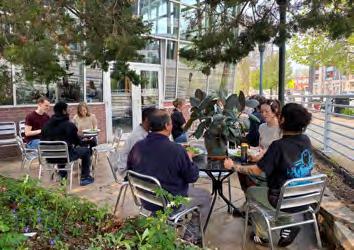

CAFÉ
CORAZON
Multi locations in Bay View, Riverwest & Brown Deer
Corazonmilwaukee.com
The Riverwest location along the Beerline Trail complements the restaurant's bright, fresh Mexican-inspired food. In Bay View, you'll find a quiet, artsy patio tucked away from the hustle and bustle of Kinnickinnic. The Brown Deer location hosts the largest Corazon patio with seating for 60. It too is off the Oak Leaf Trail and will feature its own outdoor bar.
CAMINO
434 S. Second St. Milwaukee
(414) 763-0232
Caminomke.com
Tucked away in a narrow alley, you’ll find a lush green landscape at Camino in Walker’s Point. It’s truly a hidden gem amongst downtown patios. Summer is short - come imbibe and get down with some killer bar food in this outdoor oasis while you can. Kitchen open late.

 Illustration by Tim Czerniakowski.
Photo courtesy of Cafe Corazon.
Photo courtesy of Beans & Barley.
Illustration by Tim Czerniakowski.
Photo courtesy of Cafe Corazon.
Photo courtesy of Beans & Barley.
52 | SHEPHERD EXPRESS SPECIAL OUTDOOR DINING & DRINK
Photo courtesy of Camino.
Photo courtesy of Cafe at the Plaza.




JULY 2023 | 53
FIVE O’CLOCK STEAKHOUSE
2416 W. State St. Milwaukee
(414) 342-3553
Fiveoclocksteakhouse.com

Relax and enjoy your supper club experience on our intimate patio lined with beautiful flowers and firepit. Five O’Clock Steakhouse specializes in serving award winning steaks and seafood paired with a notable wine list, classic cocktails, and outstanding, personalized service.



GREAT LAKES DISTILLERY
616 W. Virginia St. Milwaukee
(414) 431-8683
Greatlakesdistillery.com
Open daily, our tasting room is the perfect spot to relax with friends and family. We offer daily tours, a spacious, pet-friendly patio, and crafted cocktails –including alcoholic slushies–made with the small batch spirits we make on-site. Book a tour, see upcoming events, and our current cocktail menu at greatlakesdistillery.com. Tasting Room & Retail Hours: Mon.-Thurs. Noon-9pm, Fri. Noon-Midnight, Sat. 11am-Midnight, Sun. 11am-7pm.
LOST VALLEY CIDER CO.

408 W. Florida St.
Milwaukee
Lostvalley.com

Lost Valley Cider Bar serves up the largest selection of ciders from near and far. Featuring over 50 different ciders to choose from plus cider slushies, spirits, and craft beer. All of Lost Valley is dog friendly, both inside and the large outdoor patio. Check out their free live music Fridays and Wednesday trivia nights.
SALA
2613 E. Hampshire St.
Milwaukee
(414) 964-2611
Saladining.com
Experience a taste of Sicily close to home with award-winning chef-made dinners, an expansive cocktail menu, and an international wine list featuring Sicilian and Italian wines. You'll leave satisfied and part of the family. Enjoy the summer with a creative specialty drink on the SALA patio or an after-dinner drink at the bar.

15744 W. National Ave. New Berlin (414) 505-5121
Sunnysideupcafenb.com
No upcharge for this eccentric-infused MASTERPIECE. This month features sliced lemons, limes, oranges, ruby red grapefruit, strawberries, currants, and raspberries as well as red, and yellow bell peppers horseradish root, and carrots. Don’t forget about our mimosas and our outdoor dining! Follow the Pup to Sunny Side Up - New Berlin
VON TRIER
2235 N. Farwell Ave.
Milwaukee (414) 272-1775
Vontriers.com
Celebrating 45 years as a staple of Milwaukee’s East Side! Saturday, July 8th. An all-day event including Spanferkel, live music, Hammerschlägen, Liter Hoister contest, and late night DJ session.
Photo courtesy of Five O'Clock Steakhouse.
Photo courtesy of Great Lakes Distillery.
SUNNY SIDE UP CAFE
Photo courtesy of Sala.
Photo courtesy of Sunny Side Up Cafe.
Photo courtesy of Von Trier.
Photo courtesy of Lost Valley Cider Co.
54 | SHEPHERD EXPRESS SPECIAL OUTDOOR DINING & DRINK



Robin Pluer back for bastille days
BY DAVID LUHRSSEN
she’s outstanding in any setting. Robin Pluer, not flashy but distinctive, wearing a hat and clad in something chic, whether a thrift store discovery or her own creation. Musically and sartorially, she was the ideal partner for Paul Cebar in ‘80s Milwaukee. “I went up to him and introduced myself,” she recalls. It was circa 1979, Cebar was singing Mose Allison at UWM’s 8th Note Coffeehouse. “No one looked like him,” she continues. “Baggy tapered pants, slick-back hair, a Guatemalan bag, a beautiful hat.”
Pluer and Cebar gained regional popularity in the ‘80s as members of the R&B Cadets. After the band broke up, Pluer married, moved to New York, divorced after 9/11 and returned to Milwaukee where she remains a local treasure, performing regularly in lowkey settings and on stage each July at Bastille Days.

Music surrounded Pluer who grew up with her older brother’s Motown records and her Polish uncle’s concertinas. She joined an all-girl band in third grade and learned sight-reading in choir at Muskego High School, where she met saxophonist Juli Wood, a future R&B Cadet and occasional accompanist for Pluer nowadays. “My dad got me my first singing job,” she says. “He cut it out of the want ads— Wanted: Singer for Disco Group.” The year was 1977, the group was called Night Fever and it was “Fly, Robin, Fly” for a year and a half. “Singing disco wasn’t my cup of tea,” she insists, but the experience helped hone her as a performer.
Pluer and Cebar, sometimes accompanied by saxophonist Rip Tenor and
bassist Al Anderson, began performing together in 1979 as The Milwaukeeans. By 1981 they teamed up with the band formed by Kenosha brothers John and Mike Sieger, the R&B Cadets.
KIND OF AMAZING
Her calendars from the early ‘80s were full. Whether with the Milwaukeeans or the Cadets, she sang almost every night of the week. “It might be Monday at Hooligan’s, Tuesday at Teddy’s, Wednesday in Green Bay, Thursday in Chicago, Friday at Century Hall and Saturday at Harpo’s,” she says. “It was kind of amazing. Music is all I’ve ever done in my life to make money. It was never a lot of money, but I could make $25,000 a year in the early ‘80s with rent at only $150 a month!”
She came closest to stardom, regionally, with the R&B Cadets, but the band broke up shortly after the release of their 1986 album Top Happy when the Sieger brothers were offered a contract by Warner Bros. for their other band, Semi Twang. “For me, all is forgiven,” she says. In recent year, the R&B Cadets have regrouped for occasional shows at Shank Hall and private parties.
“COVID put a definite feeling out there for listening and appreciating live music,” Pluer says. She performed numerous “porch concerts” in front of her home and the houses of friends in Milwaukee’s East Side and Wauwatosa. Word of the events spread by Facebook, Nextdoor and through neighborhood associations. “Some concerts were in the dead of winter— people were sitting in parkas on lawn chairs, they were so hungry for live music,” she recalls. Two years on, Pluer still performs porch concerts, often
accompanied by such esteemed local musicians as Peter Roller and Glen Ash. However, Cathedral Square will be the site of her biggest concert this year, the annual Bastille Days performance of songs associated with Edith Piaf, Lili Patouchou, Catherine Souvage and other midcentury French songbirds. She first performed at Bastille Days in 1995 and has returned every year except the two years when COVID cancelled the festival. Plauer had lived in France for one year as a high school exchange student and loved the culture, but never thought of singing French songs until Milwaukee promoter John Ertl contacted her about Bastille Days.
“I locked myself in my pantry and learned those songs,” Pluer recalls. “Every time I sing them, they feel fresh and real—they never get old.” Although most of the audience won’t speak French, “music is the international language,” she insists. “You don’t need to understand anything but the emotion. I just appreciate that people keep coming to see me sing. There’s no such thing as retiring for a musician! It’s what I do and who I am, and as I get older, I’m happy people are still coming out and supporting me.”
Robin Pluer will perform July 15 and 16 at Bastille Days and with the R&B Cadets on Aug. 7 for Musical Mondays at Lake Park.
David Luhrssen is coauthor with Bruce Cole and Philip Naylor of Milwaukee Rock and Roll 1950-2000: A Reflective History and is Managing Editor of the Shepherd Express
58 | SHEPHERD EXPRESS CULTURE
Photo courtesy East Town Association, by Melissa Miller. Swooshes by serkorkin/Getty Images.




JULY 2023 | 59
SPARKS
12 THINGS TO DO IN JULY 12 THINGS TO DO IN JULY This Month in Milwaukee
 BY STEVE COHEN, ALLEN HALAS, ELIZABETH LINTONEN, DAVID LUHRSSEN, SHANE MCADAMS AND BLAINE SHULTZ
BY STEVE COHEN, ALLEN HALAS, ELIZABETH LINTONEN, DAVID LUHRSSEN, SHANE MCADAMS AND BLAINE SHULTZ
ALL
SUMMER LONG
Sculpture Milwaukee
Milwaukee’s Downtown
As Sculpture Milwaukee matures with each year, more and more sculpture take permanent residence in our downtown. Roxy Paine’s brilliant Cleft and Tony Cragg’s Mixed Feelings, to name only two, have quickly become valued visual accessories to our daily routines. Slowly but surely all these idiosyncratic treasures will vine out and fill the plazas with artistic counterpoints to the practical and the architectural. It’s worth an afternoon stumbling upon them as they continue to propagate and develop. You’ll definitely see some great art if you do, and you just might stumble upon your city at the same time.
JULY 6
Sparks
The Pabst Theater
Led by brothers Ron and Russell Mael, Sparks have been one of rock’s best kept secrets since the early ‘70s. The cult band relied on a quirky image to go along with genre-hopping music and intelligent lyrics stuffed with cultural refences, but never quite hit the big time. The 2021 documentary The Sparks Brothers is a dive into the Mael’s history that includes gushing praise, seemingly from everyone not named Grohl or Bono.
 Photo of Sparks courtesy of The Pabst Theater Group.
SCULPTURE MILWAUKEE
Photo of Sparks courtesy of The Pabst Theater Group.
SCULPTURE MILWAUKEE
60 | SHEPHERD EXPRESS CULTURE
Brian Pfister/ Sculpture Milwaukee



JULY 2023 | 61
JULY 7


Craig Owens, Kurt Travis, Moxy the Band, Voila X-Ray Arcade

Craig Owens has been in and around the world of metalcore since the heyday of the Vans Warped Tour. However, while many of his contemporaries have resorted to nostalgia plays, Owens continues to push himself into new projects, with his latest endeavor being a solo project that he’ll bring to X-Ray Arcade this month. He’ll be joined by Kurt Travis, formerly of Dance Gavin Dance, as well as up-and-comers Moxy the Band and Los Angeles-based duo Voila. While the term “elder emo” has gained steam, Owens and this bill will benefit those looking to continually progress.
JULY 8
Carnival of Bass featuring VLCN, Spexx, Creating.A.Movement and more Miramar Theatre
This one is for the new age headbangers who crave some extra low end in their life. The Miramar Theatre will host a massive MVMNT-curated bill with the Carnival of Bass, amassing nine DJs and producers together on one stage for a big night of bass music. With headlining sets from VLCN, Spexx and Creating.A.Movement, the night will also feature back-to-back sets with Jonin, Nimit and Nghtgrind, as well as Florida’s Exoplanet, Isolit and Lockvibe. Get ready to rave all night at the Miramar.
JULY 13
Storm the Bastille
Milwaukee’s Downtown and Third Ward Bastille Days marks the return of Milwaukee’s nighttime 5K walk-run and the run marks the start of the 40th annual festival commemorating the spark that launched the French Revolution. In past years, some runners embrace the theme by wearing creative, French-inspired outfits. If you’re not in the mood for a 5K workout, just check out the festival in the Cathedral Square Park (July 13-16) with live music, international cuisine and marketplaces, chef and wine demos, and roaming busker entertainment.

JULY 13
Andrea Bartz
Elm Grove Library
Insecurity I a consistent theme in the bestselling fiction of Andrea Bartz. In her fourth novel, The Spare Room, anxiety resides within intimate relationships as well as gated communities. Nothing is ever as pretty and perfect, or as safe, as first appears.vThe Milwaukee expat (and onetime Shepherd Express intern) has been called, in the Los Angeles Times, the “master of the feminist thriller.” Her novels are page turners with female protagonists in danger. The women in her lead roles are pinpoint characterizations of middle-class Gen Xers or Millennials, adulting in an era of dreams suspended indefinitely. Bartz and her sister Julia (also a bestselling author) will discuss The Spare Room at 6:30 p.m.
 CRAIG OWENS
Photo courtesy xrayarcade.com.
Photo courtesy East Town Association, by Melissa Miller.
CRAIG OWENS
Photo courtesy xrayarcade.com.
Photo courtesy East Town Association, by Melissa Miller.
62 | SHEPHERD EXPRESS CULTURE
STORM THE BASTILLE





JULY 2023 | 63
JULY 14
Spider Creek, DarylAnne, MeloCHLD, Shadi
Anodyne Coffee Roasters
The collective known as Spider Creek is massive, with musicians, producers, visual artists and much more comprising their roster. At times, the roster may balloon up to as many as 30 creatives, coming together to form a united front. While rooted in hip hop, the self-proclaimed “genre-fluid” musicians will bring a variety of sounds to Anodyne Coffee Roasters on July 14, with likeminded Milwaukee acts DarylAnne, MeloCHLD, and Shadi bringing a glimpse of rising talent to Walker’s Point. Spider Creek and its many facets feel like a core component of the future of Milwaukee music, and you’ll experience that for yourself at Anodyne Coffee Roasters.
JULY 15
Poster Children
Cactus Club
The University of Illinois UrbanaChampaign has a rich history of punk and pop bands. The high energy Poster Children released a series of albums in the ‘90s, even danced with major labels a few times and lived to tell about it. Here’s a chance to see the DIY outfit on a bill that includes Conan Neutron & the Secret Friends, and Delicious Monsters.

JULY 14
Diet Lite, Mr. Mota, Shoobie, Fellow Kinsman Cactus Club
In the fallout of pandemic lockdown, a host of new bands emerged, predominately on Milwaukee’s East Side. Amongst the leaders of that scene are Diet Lite, who headline a bill of manic indie rock at Cactus Club on July 14. When they’re not touring, or going viral for playing trademark guitar riffs alongside Weezer, Diet Lite are putting out stellar albums like 2023’s Into The Pudding, and this show will bring along Mr. Mota, Shoobie, and Fellow Kinsman from basement gigs into the Bay View mainstay.
JULY 16
Armenian Fest
7825 W. Layton Ave., Greenfield
This year’s Armenian Fest will be held 11 a.m. to 6 p.m., July 16 on the grounds and in the culture hall of St. John the Baptist Armenian Orthodox Church. The menu will include chicken, beef and luleh kebob; cheese and spinach burek, lamajoun (a pizza-like dish served on thin tortilla dough), hummus, vegetarian sarma and an array of baklava and other pastries. Traditional Armenian music and dancing will be performed live outside. Armenian Fest also features church tours and a culture booth selling books, artifacts and Armenian wine by the bottle.

JULY 18
Beth Nguyen
Boswell Book Company
Tuesday, July 18, 6:30 pm

Owner of a Lonely Heart is a story of reconnection that is sure to nourish the soul. Join Beth Nguyen for a conversation that features her inspiring story of rediscovering her relationship with her mother. Nguyen’s vivid writing and enlightening perspective make this coming-of-age story the perfect summer memoir. The book talk for Owner of a Lonely Heart will take place at Boswell, 2559 N. Downer Ave., July 28, at 6:30 p.m.

JULY 22






Ivan Singh
Granville Blues Fest
Growing up with his single mom in Argentina, Ivan Singh heard B.B. King and Buddy Guy early on, and started playing guitar at the age of five. He has now sat in with and gotten approval from Buddy Guy at Guy’s Chicago nightclub Legends. His first record came out in 2019, and he describes it as a kind of R&B with blues guitars and a salsa vibe. He is comfortable singing blues in Spanish as well as English, and his guitar style brings to mind Albert King. Singh headlines the first day of this year’s Granville Blues, running two weekends, July 22-23 and July 29-30, at 8633 W. Brown Deer Road. Other headliners include Jamiah Rogers (July 23), New Orleans Beau (July 29) and Mike Wheeler (July 30)
 Spider Creek via eventbrite.com.
Photo by Don Rask.
ARMENIAN FEST
Photo courtesy Granville Business Improvement District.
Spider Creek via eventbrite.com.
Photo by Don Rask.
ARMENIAN FEST
Photo courtesy Granville Business Improvement District.
64 | SHEPHERD EXPRESS CULTURE
IVAN SINGH




JULY 2023 | 65
DEAR RUTHIE,

It’s summer and that means one thing to my girlfriend— time to get crazy. Don’t get me wrong. I like to party and have a good time too, but she takes things to a new level all summer.

She wants to have people over all the time, gets drunk most nights of the week, parties every weekend and more. She’s great the rest of the year but unbearable all summer. I just can’t go through another summer like last year. She actually got a DUI! Any advice on how I can tame her ways this summer?

HELP, Desperate Diane
DEAR DESPERATE,

We all like to party in summer—we’re from Wisconsin, for God’s sake! It sounds, however, like your lady takes things to extremes. At the very least, she’s taking things to an extreme for you.
Use last summer’s history as an example of what you don’t want to occur this season. In other words, have a good talk with her. Let her know how her actions are affecting you personally and how her behavior upsets summer fun for you as a couple. Increase your communication and she may reconsider her partying ways.

HEAR ME OUT DEAR RUTHIE | SPONSORED BY UW CREDIT UNION 66 | SHEPHERD EXPRESS
XXOO Ruthie SUMMER CRAZINESS Have a question for Ruthie? Want to share an event with her? Contact Ruthie at dearruthie@shepex.com. Follow her on social media, too! Facebook: Dear Ruthie | Instagram: RuthieKeester | Twitter: @DearRuthie
Ruthie's Social Calendar
JULY 8 & 9

FRIDA FEST AT THE FARMHOUSE PAINT BAR & BANQUET HALL (4511 S. SIXTH ST.): Celebrate the life of Frida Kahlo during this annual party. In addition to live mural paintings, interactive art installations and art vendors, you’ll find live music, food and the now-famous Frida Kahlo look-alike contest. See www.farmhouseart.com for tickets and event details.
JULY 13
OPENING NIGHT DISNEY’S THE LITTLE MERMAID AT SUNSET PLAYHOUSE (700 WALL ST., ELM GROVE): This under-the-sea classic comes to life with an exciting new production. Take in the family-friendly musical before the spectacle closes August. 6. See www.sunsetplayhouse.com.
JULY 13 – JULY 16


BASTILLE DAYS AT CATHEDRAL SQUARE PARK (520 E. WELLS ST.): This incredible, four-day event attracts more than 250,000 attendees, making it the largest Frenchthemed fest in the country. Take in the food, live entertainment and iconic Eiffel Tower replica, and don’t forget the nighttime “Storm the Bastille” run/walk on Thursday.
JULY 15
“JINKX MONSOON EVERYTHING AT STAKE” CONCERT AT PABST THEATER (144 E. WELLS ST,): Two-time “RuPaul’s Drag Race” winner and Broadway star Jinkx Monsoon comes to Milwaukee with her bewitching show. Nab tickets to the 18+ concert at www.pabsttheatergroup.com.
JULY 18
WISCONSIN LGBT CHAMBER’S OUT IN THE KITCHEN AT DISCOVERY WORLD

(500 N. HARBOR DR.): Enjoy all the tasty samples your tummy can handle during this 6-8 p.m. fest spotlighting members from the state’s LGBT Chamber of Commerce. Vote for your favorite bites when you get your tickets at www.eventbrite.com.
JULY 20 – JULY 22

MALIBU DREAM LOUNGE VIP MOVIE EXPERIENCE AT AVALON ATMOSPHERIC THEATER (2473 S. KINNICKINNIC AVE.): Step into this real-life Barbie Dream House where you’ll find craft cocktails, mocktails, raffles, photo opportunities and more before viewing the movie “Barbie.” See www.avalonmke.com for tickets.
JULY 22
CASTAWAYS/PRIDE RIDE WISCONSIN DINNER RUN AT HARBOR ROOM (117 E. GREENFIELD AVE.): Hop on your cycle and meet up with the Castaways Levi/ Leather social club and motorcycle enthusiasts Pride Ride Wisconsin. The groups join forces at Harbor Room at 10 a.m. before hitting the road for drinks, dinner and fun at a campground in Hilbert. See www.castawaysmc.org for details.
JULY 26
GRAB & GO DINNER PICKUP AT MILWAUKEE LGBT COMMUNITY CENTER (315 W. COURT ST.): Need a little help getting by? The city’s LGBTQ+ community center is here for you. Stop by the center and get a feel meal to enjoy at home. Simply contact ccarter@mkelgbt.org by noon at least one day prior to have a meal held for yourself.
JULY 28
OPENING NIGHT ALANIS MORISSETTE’S JAGGED LITTLE PILL THE MUSICAL AT MILLER HIGH LIFE THEATRE (500 KILBOURN AVE.): The music of Alanis Morissette comes alive as told through a “perfectly imperfect family” in this hot new show. Featuring all the Morissette favorites you love, original songs and an incredible cast, this exciting production moves on after its July 30 performance, so get tickets soon at www.pabsttheatergroup.com.
DEAR RUTHIE BROUGHT TO YOU BY JULY 2023 | 67
The End of an Era: After Three Decades, Milwaukee's LGBTQ Literary Oasis, Outwords Books, Closes
 BY PAUL MASTERSON
BY PAUL MASTERSON
The recent closure of Milwaukee’s only LGBTQ dedicated book shop, Outwords Books, Gifts and Coffee, one of few remaining independent shops of its kind nationwide, has ended an era of Milwaukee queer history. An irreplaceable cultural asset, Outwords represented a welcoming destination not only for the local literati but also for the full spectrum of the community.
When proprietor Carl Szatmary opened the shop in 1993 (originally under the name “Afterwords”), he had already established his credentials as a passionate arts activist. Over a decade earlier he helped found the Milwaukee Gay/ Lesbian Film Festival. Held annually at the UWM-Union, it would evolve to become another Cream City institution, the Milwaukee LGBT Film/Video Festival. Under the auspices of the UWM-Film Department of the Peck School of the Arts, the festival would continue for nearly three decades. Szatmary was also a prolific critic, penning book and movie reviews (the latter under the nom de plume Glenn Bishop) for the local LGBTQ press.
Tucked away from the madding crowd, Outwords was situated in a quiet residential neighborhood not far from UWM’s upper East Side campus. Especially in its early years, that made the cozy corner location a safe destination for those looking for a good gay read, where one could peruse books, magazines and beef cake calendars to their heart’s content without having to out oneself in a retail book store’s “LGBT” section.
When I interviewed Szatmary in June 2017 on his receipt of the Shepherd Express LGBTQ Progress Award, he told me, “We get a lot of college kids, still today, who come and look
around to see what kind of store it is. Sometimes that’s OK, and sometimes they’d giggle and run off, but sometimes that group of giggling kids included somebody who came back subsequently on their own.” In fact, lovers met there as testimonials posted on the shop’s social media page reveal. Szatmary was also among the first PrideFest vendors setting up on the grounds with stacks of popular titles and assorted rainbow gifts and souvenirs.
SMART COMPANY

Naturally, it was the perfect place for those just looking for some smart company. The coffee bar with half a dozen stools offered a relaxing opportunity for chit chat with fellow customers or to probe the mind of the proprietor himself for insightful reading tips. Christmas cookie parties were the highlight for the holiday season for the customers and writers. Philanthropist Joe Pabst would stop into Outwords regularly to buy up the latest releases and donate them to the LGBT Community Center library.
Speaking of smart company, Szatmary regularly hosted local, regional and national writers for readings and book launches. Latina poet Carmen Murguia appeared in February of this year. Over the decades, dozens of celebrated literary personalities appeared, included leading gay romance novelist Andrew Grey, (my mentor, whom I joined on one occasion to read from my first published short story ) and Olympian Greg Louganis.
Since 1994 it was home to the Outwords’ book clubs for lesbians, gay men and trans readers with Szatmary suggesting the titles to choose from. While only the men’s group continues today, even the COVID pandemic could not dampen
 Photo by Michael Burmesch.
Photo by Michael Burmesch.
HEAR ME OUT | SPONSORED BY UW CREDIT UNION 68 | SHEPHERD EXPRESS
the enthusiasm of those avid bookworms. In 2020, the Gay Men’s Book Club shifted from monthly in-person meetings to ZOOM and continue that cyber connection today with Szatmary remaining as its literary guide. (Book Club member Larry Wheelock welcomes new readers to join. He may be reached through his personal social media page or by email at LLWheels@me.com)
But time and progress took their toll on Outwards viability. Ever expanding alternatives to the printed book, big box business competition, and even the advance of LGBTQ rights reduced the need for the small, independent gay book seller. Coupled with the impact of the COVID pandemic and Szatmary’s own health concerns, Outward’s fate was sealed.
For any enterprise, a 30-year run is impressive, but Outwords Books was historic. As a unique and enduring microcosm of Milwaukee’s LGBT community, it nurtured an aspect of our spirit that bars and other organizations did not. We owe Carl Szartmary for all those years.

While we celebrate progress, it always comes with a cost. I’m reminded of the famous refrain from Joni Mitchell’s “Big Yellow Taxi”: “Don’t it always seem to go, that you don’t know what you’ve got ‘til it’s gone.”
Paul Masterson is an LGBTQ activist and writer and has served on the boards of the Milwaukee Gay Arts Center, Milwaukee Pride, GAMMA and other organizations.

JULY 2023 | 69
From The City That Always Sweeps
BY ART KUMBALEK
I’m Art Kumbalek and man oh manischewitz what a world, ain’a? So listen, here we be into the hotsy-totsy /bugsy month of July, the center-core of the brief extravaganza of what we call summertime here in the upper Midwest belonging to the country of amber waves of spacious skies filled with waves of grain in a fruited plain to crown thy good with brotherhood (yeah, good luck with that, what the fock.)
I’m talking that patriotic hymn “America the Beautiful,” which really ought to be the national anthem rather than that musically un-hummable Spangled Banner hodgepodge full of ramparts and red-glaring rockets bursting in air (we gol’ darn must’ve had a topnotch air defense system back then somehow during the War of 1812, I’m thinking. But you don’t hear much about that, do you?)
Another thing you don’t hear much about is that the lyrics to “America the Beautiful” comes from a poem written by Katharine Lee Bates (1859-1929). Yes sir, Katharine. And I’m guessing that would indicate she was female, since I don’t recall that pre-Civil War Families (North or South) would often moniker a male child with the name of Katharine. You think?
But oh my, Katharine: “Thine alabaster cities gleam / Undimmed by human tears!” Not so much these days, I got to tell you. Come back from the dead and take a tour of your Baltimores, Philadelphias, Chicagos, Milwaukees— all dimmed but good by a waterfall of tears, I kid you not.
And from your original 1893 poem, the closing three lines being these:
God shed His grace on thee
Till nobler men keep once again
Thy whiter jubilee!
Ouch! “Whiter jubilee”? That doesn’t sound exactly copacetic, does it?
Oh! Also, this from Katharine’s original poem and subsequent song if anyone over the many years crooned it to its climax: from the second stanza:
O beautiful for pilgrim feet
Whose stern, impassioned stress
A thoroughfare for freedom beat
Across the wilderness!
America! America!

Whoa, Nelly—stern pilgrims beating their feet across the wilderness with impassioned stress? Hey, Geronimo, you got a shitstorm coming your way, and if you think I’m kidding, take a look at how these English focks treat their witches. Your peace pipe will soon be losing its smoke, you betcha.
Anyways, it’s sizzle-time in BeerTown and I’m declaring my independence from delivering a regular essay this month so as to dip into Artie’s Joke Satchel ’cause in the course of the oppressive and depressing human events these days, we could all use a smile, chuckle or laugh, ain’a? Let’s get to dipping, shall we?
Four retired guys are taking an early afternoon stroll in Sarasota, Fla. when they see a sign: “Old Timer’s Bar... ALL DRINKS 10 CENTS!” And so, they enter.
Bartender says “What’ll it be, gentlemen?” The men all ask for a martini. In short order, the bartender serves up four iced martinis and says, “That’ll be 10 cents each, please.”
The four retirees can’t believe their good fortune. They pay the 40 cents, finish their martinis, and order another round. Again, four martinis are produced, and the bartender says, “Forty cents, please.” They pay the tab, but their curiosity is more than they can stand. They’ve each had two martinis, and so far they’ve spent less than a dollar. One asks, “How can you afford to serve martinis as good as these for a dime apiece?”
Bartender says: “I’m a retired tailor from Brooklyn and always wanted to own a bar. Last year I hit the lottery for $50 million and decided to open this place. Every drink costs a dime— wine, liquor, beer, all the same.”
“That’s quite a story,” one of the men says. Sipping their martinis, they couldn’t help but notice three other older fellas at the end of the bar who didn’t have a drink in front of them and hadn’t ordered anything the entire time they were there.
One man gestures at the three drinkless guys and asks the bartender, “What’s with them?” Bartender says, “They’re from Milwaukee. They’re waiting for happy hour.” Ba-ding!
So, I got to go and secure my case of Old Grand-Dad for the froth of July— talk about a bottle rocket that will give (80%) proof through the night, what the fock. And let us be gallant through the perilous fight with the third-world heat and humidity of our Midwestern July so that come Aug. 1, our patriotic digits and assorted body parts remain attached and functional, god bless America, ’cause I’m Art Kumbalek and I told you so.
Photo by davidf/Getty Images.
ART FOR ART'S SAKE 70 | SHEPHERD EXPRESS













































 BY SUSAN HARPT GRIMES
BY SUSAN HARPT GRIMES



























 Photo by Davizro/Getty Images.
Photo by Davizro/Getty Images.






















 Photo by Rauf Omer Ince/Getty Images.
AFFOGATO
Photo by Rauf Omer Ince/Getty Images.
AFFOGATO





































 Illustration by Tim Czerniakowski.
Photo courtesy of Cafe Corazon.
Photo courtesy of Beans & Barley.
Illustration by Tim Czerniakowski.
Photo courtesy of Cafe Corazon.
Photo courtesy of Beans & Barley.

















 BY STEVE COHEN, ALLEN HALAS, ELIZABETH LINTONEN, DAVID LUHRSSEN, SHANE MCADAMS AND BLAINE SHULTZ
BY STEVE COHEN, ALLEN HALAS, ELIZABETH LINTONEN, DAVID LUHRSSEN, SHANE MCADAMS AND BLAINE SHULTZ
 Photo of Sparks courtesy of The Pabst Theater Group.
SCULPTURE MILWAUKEE
Photo of Sparks courtesy of The Pabst Theater Group.
SCULPTURE MILWAUKEE







 CRAIG OWENS
Photo courtesy xrayarcade.com.
Photo courtesy East Town Association, by Melissa Miller.
CRAIG OWENS
Photo courtesy xrayarcade.com.
Photo courtesy East Town Association, by Melissa Miller.










 Spider Creek via eventbrite.com.
Photo by Don Rask.
ARMENIAN FEST
Photo courtesy Granville Business Improvement District.
Spider Creek via eventbrite.com.
Photo by Don Rask.
ARMENIAN FEST
Photo courtesy Granville Business Improvement District.











 BY PAUL MASTERSON
BY PAUL MASTERSON




